







By Dana Rieck
Of The St. Louis American
In the first televised debate since the mayoral primary, St. Louis Treasurer Tishaura Jones asserted she was ready to lead the city with her experience and professional relationships, while Alderwoman Cara Spencer drove home the fact that she will come prepared to lead with a 10-point plan to address the city’s violent crime rates.
Not surprisingly, given the uptick in violent crime in recent years, the majority of questions centered on crime, policing and public safety. Those questions were asked Tuesday evening on Fox2Now by a panel
n Jones said the city needs to pivot from an “arrest and incarcerate model” to a prevention-centered model.
of local journalists, as well as by community members who submitted their inquiries online.
That panel consisted of Linda Lockhart, representing the Greater St. Louis Association of Black Journalists and the St. Louis Press Club; Michael Calhoun, a report-
er with KMOX Radio; and Gilbert Bailon, editor-in-chief of the St. Louis Post Dispatch.
Lockhart kicked off the debate after opening statements, asking how the candidates planned to address the root causes of crime.
Both candidates acknowledged the need to reestablish trust between community members and the police.
“We need to put the public back in public safety,” Jones said, an idea she reiterated throughout the night. “And that means making sure that we are deploying the right person to the right call. Not only has St. Louis experienced its most violent year in decades, we
See DEBATE, A7
By Earl Austin Jr.
Of The St. Louis American
The National Basketball Association family lost one of its most legendary figures in Elgin Baylor, who passed away on Monday. He was 86. Baylor spent his 14-year NBA career with the Minneapolis and Los Angeles Lakers. He was one of the greatest offensive players in the history of the game and a forerunner to many future great players who made many great plays while suspended in the air. When you think of great players such as Julius “Dr. J.” Erving, Connie Hawkins, Dominique Wilkins, Michael Jordan, Clyde “The Glide” Drexler and LeBron James who excited fans with their mid-air exploits, it was Elgin Baylor who was the first who brought this kind of acrobatic excitement to the NBA in the late 1950’s and 60’s with hanging jump shots and slam dunks.
A native of Washington D.C., Baylor was a collegiate star at Seattle University, where he led the Chieftains to the school’s only Final Four appearance in the NCAA
n Elgin Baylor was one of the greatest offensive players in the history of the game and a forerunner to many future great players who made many great plays while suspended in the air.
Tournament in 1957. He averaged more than 30 points during his college career. He also averaged nearly 20 rebounds a game to lead the nation as a senior. Baylor was the No. 1 pick in the NBA Draft in 1959 and earned Rookie of the Year honors in 1959 after finishing second in the league in scoring and third in rebounding. In his 14 seasons with the Lakers, the 6’5” Baylor scored 23,149 points, grabbed 11,463 rebounds and handed out 3,650 assists. He was an 11-time NBA All-Star and was
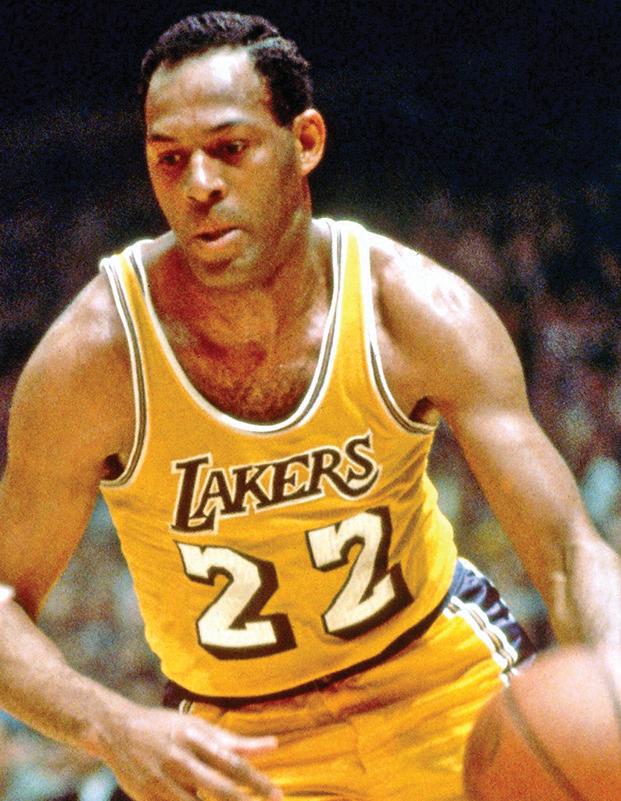
All of them accused of beating undercover officer during protest
By Christine Byers KSDK
Five more officers testified Tuesday against two former St. Louis police officers and one current officer on trial this week for beating an undercover colleague disguised as a protester in 2017. All of them varied in their recollections of who was there on the night Officer Luther Hall was assaulted, what they saw and where they were.
Perhaps one of the most significant moments came when defense attorneys suggested Sgt. Joseph Marcantano was the one who kneed Hall in the back as he was sitting on a curb — not one of the officers on trial this week.

The day kicked off with more testimony from former St. Louis Officer, now FBI Agent, Uzoma Onwumere. He testified for about four hours between Monday and Tuesday. He said he saw former Officer Chris Myers using knee strikes and rapid punches on the lower part of Officer Hall’s body. Hall was working undercover as a protester on Sept. 17, 2017, to document property damage. Along with Myers, former Officer Dustin Boone and current officer Steven Korte are on trial this week for their roles in the attack. Two other former officers, Randy Hays and Bailey Colletta, have already pleaded guilty and are awaiting sentencing.
Onwumere said Hall’s arrest caught his attention because Hall was being so quiet during the struggle, and he focused his attention on Myers for 30 to 45 seconds. Myers’ attorney, Scott Rosenblum, took Onwumere through dozens of photographs in which Onwumere insisted he
By Dana Rieck Of The St. Louis American
After three years of data collection and analysis, an outside organization has found racial disparities persist within the St. Louis County Police Department’s traffic stops and incidents of use of force.
The Center for Policing Equity (CPE) report was released March 16 during the police commissioner’s meeting. The CPE is a nonprofit research think tank based at the University of California-Los Angeles and analyzed the department’s policing practices from 2016 through 2018 to identify where racial disparities occur in policing. They also provided 10 actionable steps to correct these disparities.
Michael Burbank, accounts management and implementation director of law enforcement initiatives at CPE, presented the findings at the meeting. He said the report had three goals: identify disparities, identify the factors that contributed to these disparities and recommend actions to address these disparities.
“Findings of racial disparities are always a reason for concern,” he told St. Louis County Police Department Board of Police Commissioners on March 16. “They’re not

Instagram post inserts Claudia Jordan into Gary Owen divorce drama
Last week comedian and actor Gary Owen’s wife Kenya Duke filed for divorce in Los Angeles Superior Court. The move was first reported by TMZ.com.
This week in an Instagram post Duke put media personality Claudia Jordan in the mix of the split.
“Tried to be quiet out of respect for my kids, but @claudiajordan has me on one this morning,” The post read. “23 years together. Gary didn’t have [expletive] but a raggedy pick up and good credit, no place to live.”
The post was deleted, but not before it was screen grabbed by several urban gossip blogs –including The Jasmine Brand and The Shade Room
Duke referred to the individual allegedly involved in the infidelity as “Dallas, TX” while proceeding to call out Owen.
“@GaryOwenComedy, all the energy you spent lying, acting and creating a fake narrative for these [b-word expletive] that want to be me, you could have done it with a veggie burger and a glass of fake filtered water.”
Duke used a series of hashtags to imply that the woman is a friend to Jordan.
Jordan spoke out via Instagram to deny any involvement.
“I have nothing to do with whatever is the reason for their divorce,” Jordan said in an Instagram Live video, after saying that she and Owen have been friends for “two decades.”

“That’s my buddy,” Jordan said. “The fact that I am being dragged into this is stupid and
NBA YoungBoy detained by feds after alleged foot chase
According to Los Angeles CBS affiliate CBSLA Channel 2, Rapper NBA YoungBoy was arrested and taken into FBI custody in the Los Angeles area on March 22.
The 21-year-old rapper, whose real name is Kentrell Gaulden, was wanted on an outstanding warrant. Police reportedly attempted to stop the vehicle he was driving in an area suburb.
Apparently, he failed to pull over, which led to a short pursuit. The rapper reportedly attempted to flee on foot before he was arrested and taken into
custody Back in September, the Baton Rouge rapper was among 16 people arrested on drug and firearm charges in Louisiana.
He also served 90 days in jail in 2019 after a judge handed down a temporary probation hold in a 2016 nonfatal shooting case.
Prosecutors moved to dismiss his probation completely, which would have sent him to prison for 10 years, following his alleged involvement in a Miami shootout in 2019 that left a bystander dead.
Pastor John Gray’s choice words for Derrick Jaxn amidst cheating scandal
Social media influencer and relationship author Derrick Jaxn went viral for all the wrong reasons earlier this week. Jaxn and his wife Da’Naia went live on Instagram to confirm and discuss the infidelity rumors that had been swirling the internet.
While taking questions from social media, popular urban blog The Shade Room called Jaxn out for remarks against Pastor John Gray back when Gray was the subject of similar gossip.
“Why did you feel the need to call out John Gray when you were doing the same,” The Shade Room asked. “Is there an explanation?”
“Anything that I did – calling anybody out –especially if I aimed it at the person and not the action, was out of alignment. It was prideful and it was egotistical,” Jaxn responded. He then said that he had removed the video long before he became embroiled in his own similar controversy.
Gray hopped into the comments section of the Shade Room’s post to address Jaxn directly.
“Hey Derrick, you remember when I responded to your words about me? Remember when I posted videos about you? Neither do I,” Gray said. “I’ve learned in life that everyone gets a turn. When it was mine, I didn’t obfuscate my wrong by addressing what I know about others. I kept others’ names out of my mouth. Maybe it would be wise to do the same.”
Gray followed up to offer prayers of healing for Jaxn and his family.
“May you rise to be a better man. One moment will not define your life.”
Keyshia Cole to retire from R&B
Singer Keyshia Cole announced via Twitter that her days in the music industry are numbered.
“I’m retiring,” Cole stated – and proceeded to respond to follow up with fans, saying the brief statement was sincere and her account was not hacked.
Cole said she is contracted to do one more album for her label, BMG, but will finish the project “at her own pace.” When asked why she has decided to retire, Cole responded, “my children.” She is the mother two sons, ages 11 years and 19 months.
Sources: losangeles.cbslocal.com, TMZ.com, Instagram.com, Twitter.com, The Shade Room, The Jasmine Brand, Rap-up.com




















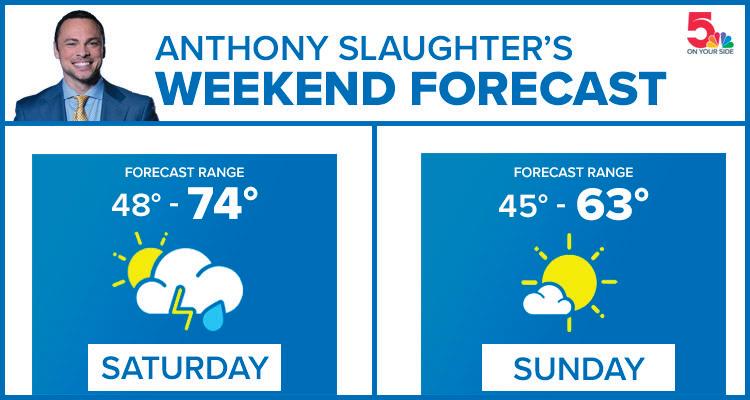













By Dana Rieck
Of The St. Louis American
The city is less than two weeks away from an historic mayoral election and 14 members of the Board of Aldermen have publicly endorsed St. Louis Treasurer Tishaura Jones, with four voicing support for Alderwoman Cara Spencer.
Alderwoman Heather Navarro, Ward 28, has endorsed Spencer along with Alderwoman Beth Murphy, Ward 13, and Alderman Joseph Vollmer, Ward 10.
The fourth member to endorse Spencer is Alderman Jeffrey Boyd, Ward 22, who is chairman of the Aldermanic Black Caucus. He endorsed Spencer for mayor March 18, even as the majority of caucus members have publicly endorsed St. Louis Treasurer Tishaura Jones.
“As chairman of the Black Caucus, I’ve worked with both candidates. I find that Cara Spencer is smart, energetic, transparent and honest,” Boyd wrote in a statement sent out by Spencer’s campaign. “She has demonstrated the ability to work well with others by passing meaningful legislation at the Board of Alderman, advancing progressive ideas to fix our broken systems and challenging policies that move us backward.”
Spencer endorsed Boyd when he ran against Jones in the August 2020 primary for St. Louis treasurer. Jones won that
primary with 17% more votes than Boyd (58.5% to 41.5%).
Jones and Boyd also both ran for mayor in the March 2017 municipal Democratic primary election. Jones captured 30.4% of the vote, just 888 votes behind current Mayor Lyda Krewson. Boyd received 2.67% of the vote in that race, which had seven total candidates.
There are currently 10 members of the Aldermanic Black Caucus, more formally known as the St. Louis African American Aldermanic Caucus.
Six of those members have now publicly endorsed Jones. Other than Boyd, no other Black Caucus member has publicly endorsed Spencer.
Prior to the primary, Jones received an endorsement from caucus member Alderman Brandon Bosley, Ward 3. After the primary election, the treasurer received several endorsements from Black Caucus members who had previously endorsed Aldermanic President Lewis Reed (who came in third in the mayoral primary). Those endorsements include Alderwoman Lisa Middlebrook, Ward 2; Alderwoman Marlene Davis; Ward 19; Alderman John Collins-Muhammad, Ward 21; Alderwoman Shameem Clark-Hubbard, Ward 26; and Alderwoman Pamela Boyd, Ward 27.
Black Caucus members Alderwoman Dwinderlin Evans, Ward 4, and
Alderwoman Tammika Hubbard, Ward 5, endorsed Reed before the primary. Neither responded to a request for comment on their current endorsement.
Alderwoman Sharon Tyus, Ward 1, is not a member of the Black Caucus but she endorsed Jones before the March primary.
Other members of the board have also endorsed Jones.
Alderman Joseph Vaccaro, Ward 23, is a previous Reed endorser and has now publicly supported Jones.
More recently, Alderman Dan Guenther, Ward 9, and Alderwoman Megan Green, Ward 15, have endorsed Jones.
Those alderpeople who endorsed Jones before the primary include alderwomen Christine Ingrassia, Ward 6, and Annie Rice, Ward 8, along with aldermen Bret Narayan, Ward 24, and Shane Cohn, Ward 25.
Those who have not publicly endorsed a candidate and did not immediately respond to an inquiry by The St. Louis American include Reed; Alderman Tom Oldenberg, Ward 16; Alderwoman Carol Howard, Ward 14; Alderwoman Sarah Martin, Ward 11; Alderman Jack Coatar, Ward 7; Alderman Joseph Roddy, Ward 17; and Alderwoman Vicky Grass, Ward 12.
Alderman Jesse Todd, Ward 18, said he does not plan to endorse any candidate.

By Jamala Rogers For the
St. Louis American

The Oprah Winfrey interview with Prince Harry and Megan Markle was a bombshell for many. The way biracial Megan was being treated by The Royals was no surprise to most of us. And some of us knew that sistah-girl was not likely to put up with it for long. A few thought out loud that Megan should’ve known what she was getting herself into—a white hierarchy wrapped in a monarchical tradition.
“60 Minutes” exposed the hurdles being placed in front of St. Louis Circuit Attorney Kim Gardner as she attempts to carry out the reform agenda mandated by the voters who have elected her twice. For her commitment to duty, Gardner faces a deluge of daily death threats. When she was sworn in as the first African-American prosecutor, should Gardner have been aware of all the racist ugliness that awaited her?
I think about other Black folks who accepted certain responsibilities and knew it would be no crystal staircase. They had to endure personal and professional attacks that their white counterparts would never have. Blacks challenging white institutions with their bodies pay a high price. This is not okay.
Black women push open the doors of organized religion to serve in the same way as male


priests, ministers and pastors. These sistahs’ expectation to be ordained and accepted by their denominations have consistently been met with resistance and ridicule.
Black cop Heather Taylor caught hell as the outspoken president of the Ethical Society of Police. ESOP represents non-white St. Louis police officers. Cop chats captured the promise of white officers to stand down if they were ever called as Taylor’s back up in her time of need.
Baseball great Hank Aaron played the sport because he loved it just like Jackie Robinson. Robinson paved the way for Blacks into professional baseball and caught hell for doing so. As Aaron approached the home run record of white icon Babe Ruth, he received hate mail and death threats. Between 1947 when Robinson
n Blacks challenging white institutions with their bodies pay a high price.
This is not okay.
crossed the color line and 1974 when Aaron crossed the home run record, there was not much racial progress on the baseball fields. Should Hank Aaron have expected this less than enthusiastic reception?
Black folks initially expressed hesitation to support Barack Obama simply because we feared for his life. We knew all too well the history of vio-
lence against Black people, especially men, who dared to stand up, who dared to buck the white status quo. We can only imagine the issue of personal safety that President Obama and First Lady Michelle had to confront on a regular basis. This thing, this notion that when Black people enter a particular white institution, they should suffer the slings and arrows silently because they know the nature of the beast, the beast being systematic racism. These courageous folks make a conscious choice to cross the line to take a stand. For this, they are required to take the bitter with the sweet knowing that their white predecessors did not. We cannot ask the Dr. Kings of the world to lead us if we don’t fight with them for our collective dignity and power. We cannot elect people to office and leave them to fight for us without us.
As for Megan Markle, I’m sure she understood that there would be some tough times as did Ida B. Wells, Thurgood Marshall, Bessie Coleman, General Benjamin Davis, Sr., Jack Johnson, Annie Malone, Josephine Baker, Crystal Bird Fauset, Tiger Woods, Venus and Serena Williams, Wesley Bell and many others who were the first in their fields. We should never leave them hanging. If you don’t know some of the people named above, do some history homework. Then engage in your human and civic duty to stand up whenever others are working to shatter the foundations of oppressive systems that limit the boundaries of human potential.

On Tuesday, March 6, voters of the city of St. Louis will go to the polls again for the second mayoral election in just over a month, to decide who will lead the city for the next four years. The city faces some tough problems, none more urgent and seemingly intractable than public safety. Any meaningful progress will be difficult and slow and will depend on an unprecedented collaboration between the city’s leadership and the entire broader community. And, it is emphatically not only a matter of police reform. Notwithstanding the promises in campaign rhetoric, there is no easy fix.
Moreover, the city’s next mayor needs to be willing and able to lead that collaboration. While they must be seasoned as an administrator, they must also be an adept politician with credibility and support across the entire city.
St. Louis desperately needs a transformative reform leader not someone aligned with those who are stuck in the past. One who is unbound from the political establishment of the past two and a half decades and their debilitating tenure that has left lingering negative effects. Voters should choose someone who has the requisite knowledge and experience in city government as well as the determination and ability to get the job done. It would be a “fool’s errand” to elect another person with strong ties to past divisive racial identity politics. This reality creates a political problem for the primary runner up, Cara Spencer. Her need for support has pushed her to support regressive measures like the aldermanic board bill that rescinds changes made in 2012. Those changes in the firefighters’ pension plan made the system more fiscally sound. Mayor Lyda Krewson, to her credit, vetoed this bill that the city budget director and the comptroller both opposed.
Recent, carping by Ald. Spencer, in apparent desperation, serves to deepen the city’s destructive divisiveness. The growing list of supporters for Treasurer Tishaura Jones is wide, deep and diverse – from the predominantly Black Ethical Society of Police to Emily’s list, a national predominantly white group of women. This great breath of support that includes elected officials from both Southside as well as Northside wards, will be essential to work together to move a forward-looking agenda for the city. (The lone Black alderman who opposes Jones is guess who – the perennially losing citywide candidate from the 22nd ward). Otherwise there will continue to be a struggle uphill against the inept status quo that has seen stagnant economic growth and the city’s population continuing to decline.

n St. Louis desperately needs a transformative reform leader not someone aligned with those who are stuck in the past.
senior team, based on merit, she can and it should be a team that voters feel has been chosen on the basis of ability, competence and commitment to diversity, inclusion and racial equity. Voters need to be assured that economic fairness is prioritized with funds from the federal stimulus package and any subsequent funding for infrastructure. She must be creative and trustworthy to be effective in dealing with longstanding grievances about a culture of racial insensitivity and unfairness in the city’s administrative fiscal policies and practices. In addition, some of the enhanced financial resources from relief funding can now be levered to incentivize more risk taking from the private sector that will help drive more badly needed economic growth.
By Adolphus M. Pruitt, II
Attention to equity and inclusion for underserved communities of color is more pronounced today than ever. In recent reporting by Peabody Award-winning journalist, Aaron Glantz, some stark statistics show discriminatory lending practices still persist. Now for those in the African American community, this comes as no surprise. But you may be surprised to learn that, shockingly, the gap between African American home ownership and white home ownership is wider today than in the Jim Crow era. In fact, systemic racial biases are essentially built-in to credit score algorithms and underwriting resulting in a continuing “access to capital” crisis for underserved communities.
Communities of color are disproportionately denied for lending products such as second mortgages or home equity lines of credit (HELOC) because credit scores include latent discriminatory filters. Further, interest rates are higher for borrowers with lower credit scores; and if credit scoring has biases against communities of color, then the unwarranted higher cost of capital acts as a “redline tax.”
Black families pay more because of systemic biases in traditional lending.
Today, what is needed are
new approaches to finance that are not weighed down by past systemic inequities and redlining. One St. Louis program, Set the PACE St. Louis, is trailblazing a new financial tool providing relief and muchneeded capital for our underserved neighborhoods.

Home ownership and the capacity to invest in and maintain a family’s biggest asset — your home — is a critical part of wealth development for communities.
The City of St. Louis Property Assessed Clean Energy program (PACE) is meeting this need by providing financing for vital energy and maintenance repairs and improvements.
100% of the costs for new heating and cooling systems, roofing, windows and doors, and other energy improvements are a part of hundreds of projects that have been completed in north city.
In fact, what is noteworthy about the PACE financing tool, is the fact that the terms and rates are the same for everybody — no matter what zip code you live in. This stands in stark contrast to traditional lending models which often
In our March 18-24, 2021 edition:
The next woman to hold the mayor’s seat in Room 200 in City Hall will face the monumental task of making common cause with the many varied interest groups in a staunchly divided city. The next mayor must recruit the strongest
Tishaura Jones’ impressive performance as a Treasurer proves she is the candidate who is best prepared to address the monumental challenges of this moment in the city. She brings the lived experiences in St. Louis of someone who has a deep understanding of and sensitivity for all of the people, especially Black people. This city remains profoundly unequal for so many of its people. That is why we feel more strongly than ever that she warrants our unequivocal support to be this beleaguered city’s next mayor.
By Marcus Robinson
When I joined The Normandy Collaborative, less than a year ago, I worried that there wouldn’t be an appetite for true reform. My question during the interview process was whether the Normandy Schools Collaborative Board had a commitment to bold change. They assured me that they did and have proven over and over that they will put the needs of children first. Even in the midst of a global pandemic and through a summer of racial reckoning, we put our heads down, rolled up our sleeves, and got to work. In just one year, we conducted a 360 degree audit of the district including feedback from students, families, and teachers to compile a research and community-informed strategic plan; adopted new, world class curriculum in both math and reading while providing teachers and leaders with best-inclass professional development; and we launched an effort to dramatically reimagine our high school, including a ballot
initiative this spring to provide the financing required to create a safer, cleaner, and betterequipped facility that serves our kids. Now, we need support from the community to transform Normandy High School. Our children are asked to learn and perform in an environment they simply don’t deserve. It is dark, gloomy, and even dangerous with pest control and asbestos a threat to the indoor spaces.

Propositions on the April 6th ballot (Proposition T and Proposition V) offer a real opportunity to continue our turnaround.
Our plans are aggressive yet lean – we will renovate to support learning. We simply cannot wait to improve the chances to learn and ultimately thrive for our students.
Our progress is measurable: In almost every grade and in
just about every building, our students are showing growth from fall to winter in English and Mathematics in the midst of the pandemic based on our i-Ready Assessments, compared to no growth for the previous four years. Our teachers and leaders have been working diligently and we have better than 80% of our instructors on pace during the adoption of our new, more rigorous literacy curriculum.
We continue to find efficiencies and outside support that have allowed us to remain in a strong financial position. This tells me that we are on the right track. If we can keep our focus on things that matter for kids, and if we, as adults, can channel some of the resilience and courage that our children have shown, we’ll emerge from this pandemic a stronger, more equitable school district where any parent would love to enroll their child.
Marcus Robinson is Superintendent Normandy Schools Collaborative.
Edited for length.
• We misspelled the last name of St. Louis Circuit Attorney Kim Gardner on the front page headline of our coverage of her segment with “60 Minutes.”
• We also made a spelling error in the front page headline caption honoring Roseann McCulley. The caption should have read, “Rally for Rosey.” In addition, Rosey was misspelled in the caption of a photo story on A7.
Stop attempting to restrict voting rights
Our state legislature tried to restrict our voting rights, only to be shot down by our Supreme Court on a voter photo ID law. Now they are trying again. This is despite having NO proof of past violation. What is needed to vote illegally without a photo? 1) You must get a utility bill, library card, etc. of another person; 2) You have to be sure they will not vote (Remember dead
people usually do not possess utility bills, etc. for you to steal); 3) They must live a good distance from you in hopes no one at polling place recognizes you (You also hope no one knows voter you are impersonating); 4) You have to find the person’s polling place; and 5) You have to be willing to go to jail if caught - for ONE vote. How many people are willing to work this hard and gamble their future - for ONE vote?
Tell your representative to stop this attempt to restrict voting rights.
Martin Walsh Glendale, Mo.
AmeriCorps, the federal government agency responsible for promoting volunteer service, recently celebrated “AmeriCorps Week” to honor over 270,000 AmeriCorps members, people of all ages and backgrounds engaged in volunteer service across the country.
fall short of meeting the capital needs of our communities. Set the PACE St. Louis is also ensuring the program’s economic opportunities are available for local minority and women owned contractor companies. For the last four years, program administrator Ygrene Energy Fund, Inc. has conducted numerous training sessions and pre-apprenticeship workshops in partnership with MOKAN, our region’s leading minority and women-owned contractor assistance center. In 2017, MOKAN recognized Ygrene Energy Fund, Inc. with a Community Partnership Award for the administrator’s commitment to equity and inclusion.
Where traditional lending institutions and mortgage banks have been shown to lend disproportionately to whites and not to blacks, the PACE program has helped address the access to capital problem by providing financing for African American families for critical home improvement and maintenance needs. Set the PACE St. Louis shows promise as a forerunner of a revolution in finance — with rates and terms the same for all program participants, this simple fact makes PACE more equitable than other financing solutions.
Adolphus M. Pruitt, II is President, St. Louis City NAACP.
All letters are edited for length and style.
AmeriCorps St. Louis’ Emergency Response Team engages 42 members every year to carry out projects related to environmental stewardship, wildland firefighting, and disaster response. These members build trails in O’Fallon Park, remove invasive bush honeysuckle along Great Rivers Greenway trails, perform prescribed burns with the Missouri Department of Conservation, fight floods along the Missouri and Mississippi rivers, and more. Since March 2020, we have also engaged in COVID-19 relief efforts by supporting testing and vaccinations sites, distributing food and PPE. AmeriCorps St. Louis is a member of the St. Louis Winter Outreach Network that provides emergency shelter to unhoused individuals every winter.
AmeriCorps programs strengthen our communities and help create the next generation of leaders who will help make our world a better place. Learn more about AmeriCorps St. Louis, visit www.acstl.org Jane Kersch St. Louis, Mo.





NNPA Newswire – In the United States, there are more than 600,000 to 800,000 people being trafficked annually across international borders and 40% percent of sex trafficking victims are Black women and girls. The panelists discussed the vulnerabilities of Black female trafficking victims, gaps in services and public policy, and the historical context of the oversexualization of Black females dating back to the Transatlantic Slave Trade. These elements coupled with poverty, racism, and a wide array of social deter-
minants feed into the vicious cycle of human trafficking. International leaders and activists promoted strategies for grassroots action to inform, prevent, and address violence against women including intimate partner-based violence, physical and mental abuse. IBWPPI shared with attendees their position paper “Slavery by Another Name: The Epidemic of Black Female Trafficking Victims in the US and Abroad.”
On Sunday, March 28, at 2pm, the Alzheimer’s Association, Friendly Temple Church, and the St. Louis Links are hosting a special phone/webinar, “Understanding Alzheimer’s and Dementia: A Discussion Honoring Women.”
The program will cover topics such as how dementia affects the brain, risk factors for the disease, potential treat-
ments, and new research. The program will be moderated by Adrienne Holden and Stephanie Griffin and will also include a panel discussion with three prominent female doctors from the St. Louis area. All who are interested in learning more about dementia are encouraged to attend this class. To learn more visit alz.org/crf.

By Cheryl D.S. Walker
This month marks one year since the World Health Organization declared COVID-19 a global pandemic. And while many may be breathing a sigh of relief with the increasing availability of COVID-19 vaccines, the trauma and disproportionate impact of the pandemic continues to unfold. From loss of family income to school closures, to a reduction in health and social services, to increased exposure to illness and death – the devastating impact of this past year on children and their wellbeing is immeasurable. We will continue to learn of the effects in the years to come.

But, for now we must meet their current needs and prepare a future for them, through public policy, that creates conditions for them to thrive.
Immediately, this requires substantive federal, state and local policy changes that are sustainable beyond the pandemic, such as:
Increasing access to comprehensive health care services by:
• equitably distributing COVID-19 vaccines so caregivers seeking to be vaccinated in communities with increased risk of illness and death have access to vaccines; and
• implementing Medicaid expansion in Missouri so more children and families are insured and have access to health, particularly behavioral health services.
Positioning families to achieve economic stability by:
• expanding, extending and distributing housing assistance to prevent displacement;
• permanently expanding the federal Child Tax Credit which would allow qualifying families to reduce their income tax burden;
• creating an Earned Income Tax Credit in Missouri which would reduce the tax burden for 494,000 families with low earned incomes;
• eliminating barriers to Temporary Assistance for Needy Families (TANF) and increasing the maximum benefit in Missouri to provide families with cash assistance to meet immediate needs; and
• increasing wages so that workers earn family-supporting and living wages.
By no means is this list exhaustive. However, these few, but mighty, sweeping policy changes will meet immediate and future needs of thousands, and in many instances, millions of children and families. What we have learned this past year is that child advocates have been right all along. The policies they have been championing for years are not only good for children but for everyone, and dare I say the economy. We must do well by our children.
In service to our children.
Cheryl D.S. Walker is the interim president and CEO of Deaconess Foundation.

Continued from A1
wholly attributable to the decisions or practices of law enforcement. In other words, observed racial disparities do not indicate an officer has prejudiced beliefs or that they have engaged in discriminatory behavior.” Burbank went on to say that instead, crime, poverty, institutional neglect and a “host of other factors” can influence and drive racial disparities when it comes to policing.
Among significant findings were that while Black/white disparity in vehicle stops declined, Black drivers were still more likely to be stopped per capita than any other race. In addition, Black drivers experienced higher rates of arrest (6% of Black drivers were arrested compared to 4% of white drivers) and Black male drivers were twice as likely to be searched during those stops than white male drivers. However, during those searches police found contraband at about the same rate for white drivers compared to Black drivers.
In addition, Black people were three times more likely to experience use of force than white people when interacting with St.
Continued from A1
could not identify any officers, including himself, in an effort to show how the assault Onwumere described Myers carried out on Hall was not captured by any videos or pictures that night.
In his closing, Rosenblum asked Onwumere if Myers dated his ex-girlfriend’s sister, and introduced Onwumere’s
Louis County police officers, and those numbers were “not fully explained by the neighborhood characteristics and crime rates of the areas where the incidents occurred,” according to the report.
Some of the recommendations outlined in the report directed the police department to:
• Begin collecting data on pedestrian stops
• Clearly define reportable force and include any use-offorce incidents
• Require supervisors to review vehicle stop reports in a timely fashion
• Adopt a policy explicitly requiring officers to intervene if they see a fellow officer using excessive force
• Prohibit the use of chokeholds and neck restraints
• Build on the police that prohibits “hog-tying” techniques by prohibiting officers from placing body weight on the back of a prone, restrained individual
• Work with local LGBTQ+ communities to implement the policy changes
“The report is the first step on moving forward on some of these programs, the hope is that we can partner with St. Louis County and continue this relationship and see how disparities
ex-girlfriend to a different man. Onwumere said he did, but added his ex-girlfriend eventually married Myers’ friend and he attended the wedding.
Sgt. Joe Marcantano took the stand after Onwumere, telling First Assistant U.S. Attorney Carrie Costantin he was “mortified” when he took Hall’s camera off of his neck and dropped it accidentally. Rosenblum showed him a series of photos from the night in question, which showed Myers in front of Hall and
are impacted over time based on changes in department has made themselves and changes based on our recommendations,” Burbank said.
Board members said they were still reviewing the entire report and would incorporate the findings and recommendations into their plans to continually improve the department.
A media release from the police department later that day stated it “has or is in the process of implementing the majority of the steps.”
The study was funded by National Science Foundation, Google.org, the Players Coalition, Joyce Foundation, Silicon Valley Community Foundation and Lyda Hill Philanthropies.
A PDF version of the full report can be found at https://bit. ly/3f84u5L.
This report comes shortly after a separate 42-page report was released in mid-December by Teneo Risk. The study consistently reiterated that employees of the St. Louis metro and county police departments think the agencies lack cohesion and unity — which has led to, in part, to a fire-fighting mentality “in which they respond reactively to all calls for service in the absence of a clearly-articulated organizational plan.” A
Marcantano standing behind Hall when Hall was seated on the curb. He suggested Marcantano was the one who kneed Hall in the back, not his client Myers.
Officer Taylor Hosna also took the stand. She told Costantin she didn’t see Hall’s arrest but said she saw an electronic device fall near her after it had been thrown and she could tell it was broken because it was in pieces. She also identified Korte’s voice and Hays’ voice on the audio

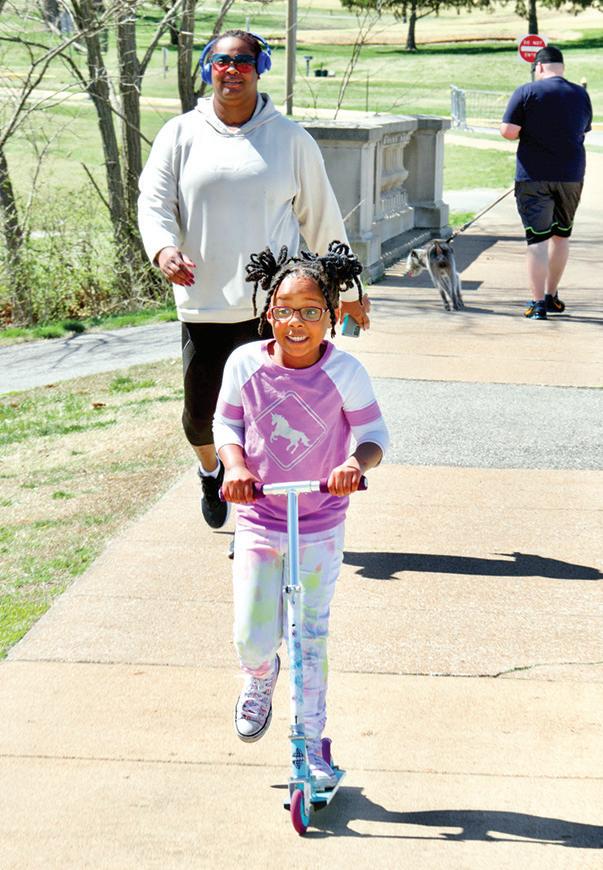
from Hall’s cellphone. She responded, “I do not recall,” to almost every question from defense attorneys, so they referred to her grand jury transcript in which she described the atmosphere the day after Hall’s arrest as that of a high school football team that had just won a big game. That night also included a controversial technique known as kettling. Dozens of people — who have since sued the city — were arrested that night when police surrounded them, including a reporter. Costantin objected, saying she was concerned questioning Hosna about her statements would bring discussion about the kettling into the trial and she didn’t want that to happen.
District Judge Catherine Perry agreed, and Rosenblum discontinued his questioning.
Attorney John Rogers, who is representing Korte, then questioned Hosna about her closeness to Hays and Colletta, noting they sometimes double-dated. He went through a list of 14 officers’ names asking if Hosna told them she identified Hays and Korte’s names after the government asked her to listen to the audio. She told them she didn’t tell anyone.
“Is that what you expect us to believe?” Rogers asked her.
Former St. Louis Officer Zachariah Foltz followed Hosna on the stand. He now works as a deputy sheriff for the Howard County Sheriff’s Office.
He, too, identified Korte as a voice on the audio he heard from Hall’s cellphone.
The overflow courtroom where the public and report-
ers are allowed to watch the proceeding lost the audiovisual feed during the closing of Foltz’s time on the stand. When it resumed about 20 minutes later, Officer Craig Schaefer was being cross-examined by Rogers, so it’s unclear what Costantin and Rosenblum asked him. Schaefer was on the stand for about the last 40 minutes of the day. After the court adjourned, prosecutors told the judge they could wrap their case tomorrow.
Perry said Rosenblum once told her defense attorneys he planned to call as many as 30 witnesses [Wednesday].
“Are you still planning to call 30 witnesses?” Perry asked. “Not even close,” he said.


Continued from A1
also are top in the nation for gun violence by our officers.”
Jones said the city needs to pivot from an “arrest and incarcerate model” to a prevention-centered model. In an answer to a later question about the over 150 vacancies at the St. Louis Metropolitan Police Department, Jones said that about half of the calls that come in to dispatch can be responded to by mental health and social work professionals.
Spencer gave an outline of her 10-point plan to address crime, which starts with focused deterrence, a crime prevention method the alderwoman said is data-driven and proven to reduce homicides by up to 50%. Jones said she also supports focused deterrence.
“Like many of our viewers tonight, crime is personal for me — I was the victim of a violent crime myself so I know how important it is,” Spencer
Continued from A1
selected to the All-NBA First Team 10 times in his career, which included eight Western Conference titles and eight trips to the NBA Finals. He
said. “That’s why when I decided to run for mayor I got serious about looking at what the city can and should be doing, taking from cities that have effectively addressed violence I put together a comprehensive 10-step plan to start to address crime on day one.”
As for issues surrounding the City Justice Center jail and the Workhouse, both candidates said they would close the workhouse and renovate the CJC. Jones said she would close it within the first 100 days of her administration, while Spencer said she would need to evaluate the city’s needs before making a decision on a closure date. The two women had different takes when it came to a question about how they would support Circuit Attorney Kim Gardner’s reform agenda and her office’s relationship with the city police department. Jones said she has supported Gardner for eight years and would work to ensure Gardner’s diversion programs find funding (noting the Board of Alderman has denied these
scored 61 points in Game 5 of the 1962 NBA Finals, which is a record that still stands today.
Upon his retirement from the NBA in 1972, Baylor spent the next four decades as a head coach and in the front office as an executive. He spent 22 seasons as the general manager of the Los Angeles Clippers.
St. Louis Community Justice Coalition sponsors forum with Jones
The St. Louis American
The St. Louis Community Justice Coalition is sponsoring its second virtual mayoral candidate forum at noon Saturday with St. Louis Treasurer Tishaura Jones. This forum will focus on public safety and the city’s departments that are responsible for ensuring fairness and safety for residents.
The Community Justice Coalition is a non-government organization formed in 2009 to advocate for reforms in justice and prison systems. Those wishing to attend can register for free at https://bit.ly/ on2mayor.

programs money) and she would insist on the ousting of Jeff Roorda, the public face of the police union.
“If they don’t get rid of him, they don’t have a seat at my table,” Jones said, also adding later in the night, when asked, that as mayor she would interview Police Chief John Hayden to ensure he was the right person to continue heading the department.
“Everything is on the table, every position is on the table, there are no sacred cows here,” Jones said.
Spencer said she would confer with other stakeholders when it came to whether she would keep Hayden in his position.
“This is not a question that I will not answer alone,” she said.
In regards to Gardner, Spencer’s focus was on rebuilding the relationship between the prosecutor’s officer and the police department. She said she supports Gardner’s reform agenda.
“We need a path for justice in our court system, if we don’t have a path through our courts we will see justice continue to play out in the streets,” Spencer said.
In other topics, Calhoun asked about tax incentives and what each candidate thought was the proper balance in the city’s use of them.
Spencer said that while incentivizing development is an important piece to driving investment into the city of St. Louis, the city “must be judicious” in using them. She said if elected she would reorient
the St. Louis Development Corporation (SLDC) to be proactive and work with communities to develop a plan to understand what incentives can be supported.
“I have been fighting back when the deals don’t make sense down at City Hall since the day I got down there,” Spencer said.
Jones said she would use the city’s money and resources toward intentional investment, and believes the city has overused the incentives in some areas. Her plan is to also reorient SLDC to make it more focused on neighborhoods and recruit a new director who has experience in developing other cities.
“Just like we saw intentional investment in downtown and the central corridor, we saw
disinvestment in areas of north St. Louis and parts of south St. Louis,” Jones said. “And so it should be no surprise that those areas are hollowing out because we have not used our development incentives to go into those areas.”
Other topics covered in the debate were public schools, city hall innovation, regional cooperation and allocating the $500 million federal stimulus the city is slated to begin receiving in May.
The one-hour debate can be watched at https://bit.ly/2P0cxqN
The St. Louis American will co-sponsor a second mayoral debate, along with media partners 5 On Your Side, Nine PBS and St. Louis Public Radio on Tuesday, March 30 on Nine PBS’s at 7:00 p.m.




By Corinne Ruff
St. Louis Public Radio
A few blocks south of Hyde Park in North St. Louis near Highway 70, contractors are gutting a row of old apartment buildings that have been vacant and boarded up for years.
These former nuisance properties are on their way to becoming charming two-family townhomes. Michael Woods, the co-founder of the nonprofit Dream Builder 4 Equity, hopes they will help draw people back to this part of town. It’s one of many northside neighborhoods that have been severely neglected by developers for decades.
A lifelong resident of Hyde Park, Woods is pioneering a new neighborhood-based strategy for community development, something he wants to see replicated across the city.
“We have an opportunity as an organization to create that perfect model,” he said. “We’re able to say, ‘This is what it looks like when you engage the right people, when you engage the community. This is what it looks like when you have people who are from the community participating and uplifting the community.’”
The city’s economic development arm, known as the St. Louis Development Corporation, is in the process of implementing a new approach. It aims to move away from a top-down model that historically focused on helping developers with their plans. Now, for the first time in decades, it has a strategic plan of its own that focuses on building up whole neighborhoods at a time.
The city still has a long way to go to make good on its promise that equity and inclusion will be at the center of this new approach, according
to groups already working on inclusive development in neighborhoods. But many are hopeful that this will be the turning point.
There’s a lot of communitydriven development going on in the Hyde Park neighborhood in north St. Louis. Nonprofit Dream Builders 4 Equity is renovating several old apartments and a daycare facility. The founder of the Hyde Park Neighborhood Association is transforming a vacant building into a gathering place called Apiary @ the Park.
The neighborhood approach
The Dream Builders’ model for neighborhood revitalization hinges on input from the community.
“We want to see this neighborhood transform, but we want to see it done right,” Woods said. “We want to make sure the community is engaged and they have the largest say in everything.”
He’s been working closely with the Hyde Park Neighborhood Association, which helped the nonprofit acquire specific properties that residents have complained about. That includes an old day care facility that Dream Builders plans to restore so that the day care can return, along with a new educational hub.
The nonprofit’s big picture goal is to complete five building rehabilitation projects per year for the next five years, as well as do free home renovations for seniors living in the community.
It’s also setting aside money to cover the cost of increased taxes for existing homeowners so that they won’t be priced out



of the neighborhood as more development comes to the area.
Woods said the work is about more than fixing buildings. The project is also providing jobs for minority contractors and dozens of young people who want to learn the trade and work toward home ownership.
“We’re definitely trying to
attack this in a holistic way,” Woods said.
Letting residents lead the change
Dara Eskridge is spearheading inclusive development farther south, in the West End and
Dutchtown neighborhoods.
She’s the executive director of Invest STL, an organization that helps community leaders and developers work together on neighborhood change, with a focus on racial equity.
Eskridge, an urban planner by trade, said the city has no choice but to switch up its strategy. She said that the old approach isn’t working, and that now the city is facing a critical moment.
“Where we’ve got this small window of opportunity to make really big, bold, almost like history rectifying change, but we have to be willing to kind of
See Residents, A12

step through that opening,” she said. “But the other part of it is, whether or not our conventional power brokers and structures agree that this is something we should do, the fact is, it is an imperative for our region’s growth.”
If the city wants to reach its full potential, she said, city officials need to start guiding investment to neighborhoods
that have been locked out of development in the past. She said that includes neighborhoods in North St. Louis, North St. Louis County and East St. Louis.
Eskridge said part of the problem is that many residents, especially those living in predominantly Black neighborhoods, have had traumatic experiences with development. She said that it’s felt extractive, instead of collaborative, and that it’s hard for people to trust the city now.
“We’ve got to allow other people in, and specifically those

who are on the economic losing side of things in our region,” she said. “If they’re not at the table to co-design solutions, we very well could re-create this whole system of inequity once again.”
Another organization, WEPOWER, is helping residents figure out how to get involved.
Shemia Reese, a resident of the Jeff-Vander-Lou neighborhood, participated in the group’s Power-Building Academy on economic justice last year. She said it helped her figure out how to talk about development in her community more effectively.
“Because some of these emotions have been bottled up for so long. When they come out, it’s just like a volcano that’s just erupted. And so you can’t distinguish between the passion, the anger, the hurt, or if they really want to make change,” she said.
Reese feels like she’s been left out of the conversation for a long time. While she’s hopeful about the city’s new approach, she has one main request.
“Include me, include the community, include the single parent, include the homeless person. Include, like — include me,” she said.
‘We’re making it happen’
Fatimah Muhammad isn’t waiting for any big developers to come around to her ideas. She started the Hyde Park Neighborhood Association a few years ago and became a developer herself. At first, she said her husband was skeptical of her idea to buy a rundown building a block from the park and fix it up as a community gathering place.
“This is what we do,” she said she told her husband at the time. “There is a problem in this community, we don’t run from it. I’m not going to walk around in my neighborhood with blinders on, so we’re going to buy this building.”
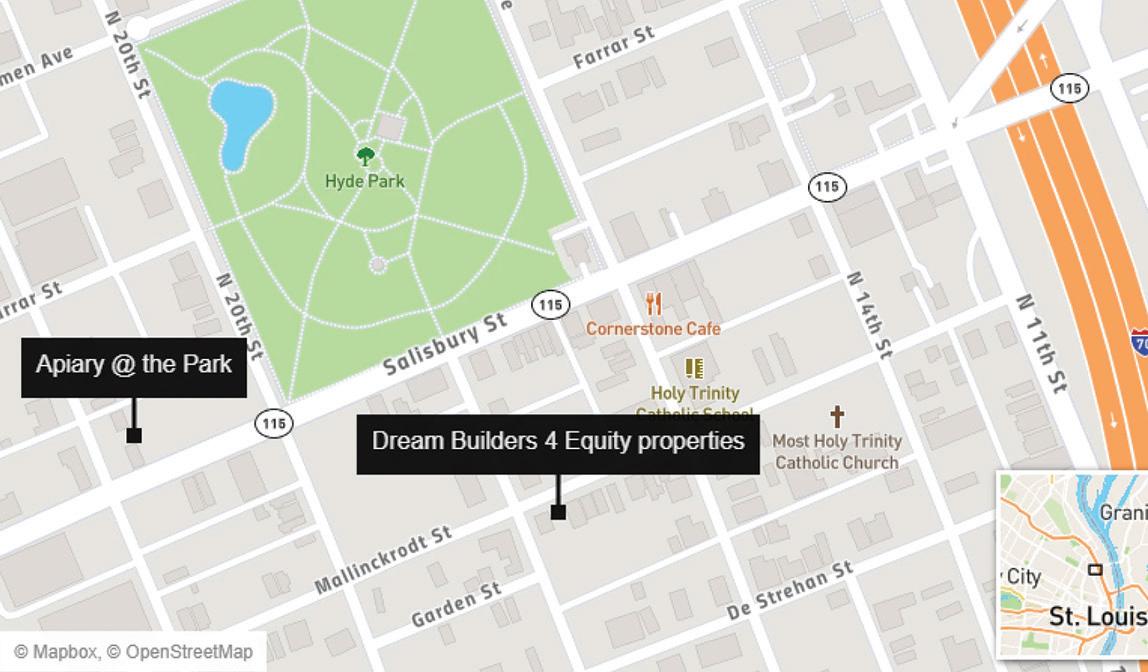
There’s a lot of community-driven development going on in the Hyde Park neighborhood in north St. Louis. Nonprofit Dream Builders 4 Equity is renovating several old apartments and a daycare facility. The founder of the Hyde Park Neighborhood Association is transforming a vacant building into a gathering place called Apiary @ the Park.
The pandemic has delayed renovations, so the old post office building is still mostly boarded up. But Muhammad has a clear vision for what she said will become known as Apiary @ the Park.
Inside, she said it will house the Be Well Café, a coworking space, a test kitchen for food entrepreneurs and apartments on the second floor. Outside, Muhammad pictures a food truck park next to a courtyard seating area, an art exhibition space and community beehives.
Muhammad, who also coordinates neighborhood development efforts with Dream Builders, said things are finally changing in the neighborhood. “Well, it’s not coming. We’re making it happen,” she said.
Ultimately, whether the city commits to inclusive development or not, these community organizers say they’ll keep pushing for residents to lead the change in their neighborhoods.
Follow Corinne on Twitter: @ corinnesusan

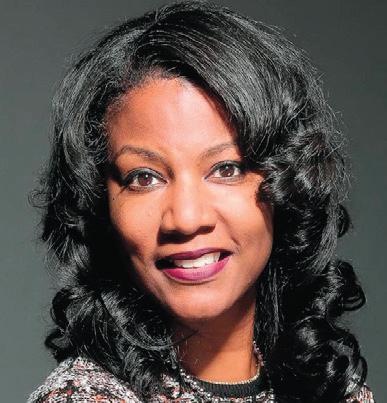

Simulcast live across all stations and livestreamed on ninepbs.org, stlpublicradio.org, and ksdk.com 7 P.M. TUESDAY, MARCH 30





For low and moderate-income families, financial pressures can make them vulnerable to high-cost, predatory lending. The irony is that while consumers using these products usually need a small amount of money, the fees that accompany these loans are really a debt trap that worsens, not improves, family finances.
By Charlene Crowell
As the nation and much of the world continue to suffer from the rippling effects of COVID-19, the ability of consumers to remain current on bills and expenses is steadily waning – if not already gone.
According to the Census Bureau’s Household Pulse Survey taken in early February, more than a third (34.9%) adults live in households where it has been somewhat or very difficult to pay usual household expenses during the coronavirus pandemic; and 30% expect eviction or foreclosure is likely in the next two months.
For low and moderate-income families, these are the kinds of financial pressures that can make them vulnerable to high-cost, predatory lending. The irony is that while consumers using these products usually need a small amount of money, the fees that accompany these loans are really a debt trap that worsens, not improves, family finances.
by the state’s Legislative Black Caucus and aided by support of a broad coalition including clergy, industry and governmental officials, the bill will cap consumer loan interest rates at 36 percent interest and affect payday, car title, and high-cost installment loans.

Access to this “quick cash” is tied to direct access to borrower bank accounts or the likelihood of car repossession from an auto-title loan. Besides owing more money for fees than for the loan itself, borrowers also experience other financial harms including delinquency on other bills, overdraft fees, involuntary loss of bank accounts, and bankruptcy.
To date, 17 states and the District of Columbia have enacted rate cap legislation, limiting interest charged to 36% or less. But there are hopeful signs that the number of consumers protected could soon increase.
For example, This January, Illinois’ Predatory Loan Prevention Act, won bipartisan legislative passage in both chambers in January. Led
Currently, Illinois borrowers pay payday and title loan fees in excess of half a billion each year. Nearly half of payday loan borrowers on the state earn less than $30,000 per year. In Chicago, the state’s largest city and home to millions of consumers of color who comprise 47% of the city’s population, zip codes in communities of color incur 72% of the Windy City’s payday loans.
According to the Woodstock Institute, an Illinois nonprofit consumer advocacy organization and coalition member, a resident of Chicago’s Austin neighborhood, where the median income of residents is $35,855 and home to mostly consumers of color, is 13 times more likely to have a payday loan than that of a Lincoln Park resident, where median incomes surpass $200,000, more than double that of the entire city’s $61,811, and real estate prices frequently reach seven figures.
If signed by the state’s governor, the bill’s enactment will end what Woodstock calculates is a 297% state average annual percentage rate (APR) on payday loans as well as the 179% average APR on auto title loans. Additional hopeful signs are found in several state capitols. A bill to cap loan rates at 36% APR has been advancing in New Mexico and bills
By Kayla Drake, Jason Rosenbaum
St. Louis Public Radio
St. Louis is expected to receive a half-billion dollars in the latest round of federal coronavirus relief funding this spring — the largest amount of any city or county in Missouri. That’s at least twice the amount going to Kansas City and St. Louis County, the next-highest projected allocations. The federal government calculated funding to cities based on poverty rates, unemployment and housing quality, not population.
n The relief money from the so-called American Rescue Plan could make up for around $90 million in revenue St. Louis lost during the coronavirus pandemic.
The relief money from the so-called American Rescue Plan could make up for around $90 million in revenue St. Louis lost during the coronavirus pandemic, as well as help with housing, St. Louis Mayor Lyda Krewson said during a press conference Monday.
“There is a looming housing crisis, a looming eviction crisis,” Krewson said. “And so a lot of our funds we expect to be used to help the unhoused population, help people that have lost their jobs.”
Officials are waiting on specific regulations for the money from the U.S. Treasury Department, but general guidelines exist.
Krewson developed a framework for how the relief money could be spent, but the next mayor will be the one actually involved in spending the money, along with
See MONEY, A14


Dwayne Proctor is named the new president and CEO of the Missouri Foundation for Health, effective May 3. With more than 20 years in philanthropy Proctor, comes from the Robert Wood Johnson Foundation in New Jersey, where he was the senior adviser to the president. Before RWJF, Proctor was an assistant professor at the University of Connecticut School of Medicine where he taught courses on health communication and marketing to multicultural populations.

Falyn Taylor was recently hired by Parents as Teachers as its national director of equity. The Missouri-based international home visiting non-profit says Taylor’s responsibilities include the continuous infusion of the fundamental values of diversity, equity, inclusion, and accessibility throughout the operations, activities, content and resources of Parents as Teachers. Taylor joins PAT from Washington University’s Relationship & Sexual Violence Prevention Center, and previously spent several years working in K-12 schools systems, supporting administration, students, and families by incorporating those same frameworks in policy and practice.

Michael S. Regan
Michael S. Regan was sworn in as the 16th Administrator of the U.S. Environmental Protection Agency (EPA) on March 11. On his first day, Regan committed to working closely with and supporting EPA’s career public servants, restoring the role of science and transparency, addressing climate change, and prioritizing environmental justice. Regan is the first Black man and the second person of color to lead the EPA. Regan returns to EPA after starting his career at the agency, rising to the role of national program manager responsible for designing strategic solutions with industry and corporate stakeholders to reduce air pollution, improve energy efficiency and address climate change.

L.
The 18th Secretary of the U.S. Department of Housing and Urban Development is Marcia L. Fudge. Throughout her career, she has worked to help low-income families, seniors, and communities across the country. Secretary Fudge served as U.S. Representative for the 11th Congressional District of Ohio from 2008 to March 9; was a member of several Congressional Caucuses and past chair of the Congressional Black Caucus. Fudge is committed to making the dream of homeownership - and the security and wealth creation that comes with it - a reality for more Americans. Under Fudge’s leadership, HUD will work to eradicate the growing homelessness issue, put an end to discriminatory practices in the housing market, and ensure that fair housing rules are doing what they are supposed to.
By Karen RobinsonJacobs For The
St. Louis American
Inhance Technologies, a Houston-based company that treats specialty plastics and chemicals, transforming them from conventional to high-performance materials, has opened a new manufacturing and warehouse facility on Hazelwood Ave. in St. Louis.
The revamped facility, replacing one opened in 1996, will increase the company’s warehouse space by 250%, and double its manufacturing capabilities. Once all roles in
have been introduced in both Minnesota and Rhode Island.
“The current economic crisis has added crushing debt onto the backs of Americans who can least afford it, which is disproportionately Black, Latino, and Native American communities,” observed Lisa Stifler, the Center for Responsible Lending’s Director of State Policy. “Payday and other high-cost, predatory loans make this situation even worse. Strong loan interest rate caps on the state and federal levels are essential to lifting the burden of debt that so many people have been forced to live with.”
Driving home this point is a newly updated map from CRL that shows the interest rate on a typical $300 payday loan. It sheds light on the financial misery of triple-digit interest rates where they are legal. Many states with large numbers of consumers of color have many of the highest rates: Texas at 664%, Missouri at 527%, and Mississippi with 521%.
At the federal level, lawmakers are expected to re-introduce a payday lending bill
the expanded facility are filled, the site will host 40 workers, which is more than the company had anticipated when the new plant was first discussed.
The diverse workforce -65% of whom are persons of color -- will occupy a 75,000 square foot facility, which is more than double the size of the old building.
The company declined to release the cost of the expansion but noted that the growth comes as consumers have become increasingly concerned about plastics’ impact on the environment.
n The revamped facility, replacing one opened in 1996, will increase the company’s warehouse space by 250%, and double its manufacturing capabilities.
is equipped to meet new levels of demand as product brands, retailers and consumers make a conscious choice to more sustainable plastics.”
total produced in the entire last century, according to a 2009 report cited by the health news source.
“The expansion in St. Louis is a great moment for the company and a sign of the organization’s ambition in sustainable solutions for plastics,” Patricia van Ee, Inhance Technologies’ chief commercial officer, said in a statement. “We know consumers are favoring more recyclable plastics, especially in packaging. We’re thrilled to expand our capabilities in St. Louis to serve the Midwest.”
that would give both consumers and military veterans the same 36% rate protection as the Military Lending Act (MLA). Named the Veterans and Consumers Fair Credit Act, the measure is hoped to secure the same broad and bipartisan support that MLA received.
Readers may recall that years ago, following extensive research and hearings, the Consumer Financial Protection Bureau (CFPB) under the Obama Administration released an administrative rule to stop payday loan debt traps.
However, under the Trump Administration, the rule was gutted by eliminating its ability-to-repay standard. This underwriting practiced by mortgage lenders, credit card companies, and other lenders, prevents lenders from extending more new debt than they can afford.
Last year, a consumer coalition wrote Congressional leaders about their opposition to removing this key underwriting, particularly when the pandemic imposed severe financial stress on consumers with the fewest financial resources. In a March 2020 letter the advocates wrote in part:
“Predatory lenders are known to prey on the most vulnerable including seniors,
Added Michael Koma, Inhance Technologies’ chief operating officer: “With a large expansion of warehouse space, a doubling of our manufacturing capacity, and new rapid-response lead times, our expanded St. Louis operation
One technology, called Enkase, creates a permanent and fully recyclable barrier for packaging regardless of shape, size, or design. It can be used as an alternative to multilayer packaging.
Nearly 360 million tons of plastic were produced worldwide in 2018, according to Environmental Health News. The amount of plastic produced in the first 10 years of the 21st century will almost match the

veterans, low-income, African American, and Latinx communities. Many in these communities were already struggling before this crisis and will fall deeper into economic instability because of it. Efforts by Congress to help Americans should not be undermined by predatory lenders trapping consumers into loans of 100% or even 300% APR. We want to ensure that relief that Congress

Rohit Chopra, President Biden’s nominee to serve a fiveyear term as CFPB Director, previously served at CFPB under Director Cordray and as the agency’s student loan ombudsman.
Chemicals added to plastics are absorbed by human bodies and there is evidence some of the compounds can alter hormones or have other potential human health effects, according to Environmental Health News. Also, plastic debris, containing chemicals often is ingested by marine life, and can injure or poison wildlife. Floating plastic waste can survive for years in water, the news service said, posing a threat to marine life.
stemming from COVID-19, millions face the prospect of losing their home, with communities of color particularly at risk. Many have seen their jobs disappear and will not be able to easily resume their mortgage payments.”
“While there are some hopeful signs that the tide is turning,” continued Chopra, “we must not forget that the financial lives of millions of Americans are in ruin. Experts expect distress across a number of consumer credit markets, including an avalanche of loan defaults and auto repossessions.”
is providing to our families is going to cover food, shelter, and other necessities, not to pay back exorbitant interest rate loans.”
With a new President and a new nominee to serve a fiveyear term as CFPB Director, federal action on payday reform could come quickly.
Rohit Chopra, President Biden’s nominee, previously served at CFPB under Director Cordray and as the agency’s student loan ombudsman. His
Continued from A13 other city officials. The election is April 6.
Mayoral candidate and city Treasurer Tishaura Jones said she would prioritize using relief money for renter and mortgage assistance, small-business assistance and homeless services, as well as a “small portion” to fund an oversight committee to “ensure equitable allocation.” Her mayoral opponent, Alderwoman Cara Spencer, said that the $500 million award is a “oncein-a-century” opportunity and that she would put the money toward stabilizing housing in the short term and investing in workforce development in the long run.
U.S. Rep. Cori Bush, D-St. Louis County, said the $500 million is vital for her district, which includes St. Louis and north St. Louis County.
“It’s going to actually transform a lot for our communities, and I think that we will start to see the effects of that very soon,” Bush said. A smaller slice for St. Louis County St. Louis County will get
March 2 nomination hearing by the Senate’s Committee on Banking, Housing, and Urban Affairs, was the second time in three years that Chopra faced Senate confirmation. Three years ago, he was unanimously confirmed to serve on the Federal Trade Commission. That bipartisan endorsement should favor CFPB confirmation. In his remarks to Senate Banking, Chopra noted, “Due to the economic devastation
around $190 million.
On Monday, St. Louis County Executive Sam Page said he expected the money to go to such needs as food distribution and bolstering the county’s vaccine infrastructure. He said it may also go toward “programs for the economic recovery.”
“We still have a large group of people in our community that are hesitant to accept the vaccine,” Page said. “And then we have a large section of our community that can’t just drive to a vaccination center. We’ll be going to some of them.”
The money comes a little less than a year after a high-profile dispute in the county over who should be responsible for dividing up COVID-19 relief.
Last year, the St. Louis County Council voted 4-3 to give Page authority to spend coronavirus relief funds.
That move meant that Page didn’t have to get approval from the council on how his administration was spending roughly $173 million in federal money.
But Page no longer has a majority of support on the council. And one member

“Congress has entrusted the Consumer Financial Protection Bureau,” continued Chopra, “with carefully monitoring markets to spot risks, ensuring compliance with existing law, educating consumers, and promoting competition. This not only helps to protect Americans from fraud and other unlawful conduct, it also ensures that law-abiding businesses, regardless of size, can compete.”
Here’s hoping that CFPB will soon return to its mission.
Charlene Crowell is a Senior Fellow with the Center for Responsible Lending. She can be reached at Charlene. crowell@responsiblelending. org.
who voted to give Page the power to spend the money, now-Council Chairwoman Rita Days, D-Bel Nor, has become a fierce critic of the county executive — especially on how he’s handled the pandemic in largely Black areas of the county.
Asked if the Rescue Plan funding would be spent similarly to the earlier federal money, basically without the council approving individual line items, Page replied, “I expect that programming will be similar to what we saw before, but certainly the council will have the opportunity to provide more detail, and that’s what I would expect.”
Nearly $78 million is expected to go to St. Charles County, around $43 million to Jefferson County and $20 million to Franklin County, the Missouri Budget Project estimated. Kansas City will receive $195 million, the second-highest city after St. Louis. The plan will send federal money directly to cities and counties with more than 50,000 residents, while smaller municipalities will get allocations from the state.
Missouri is receiving $5.4 billion for state and local aid out of the $1.9 trillion relief package. The federal government will send the first half of relief money to local governments by May 11. The second half will be sent within a year. The act requires governments to spend all of the money by Dec. 31, 2024.
Last May, St. Louis received $35 million in relief aid, which did not allow local governments to spend money on budget deficits. Without the latest package, St. Louis Budget Director Paul Payne estimated St. Louis wouldn’t have fully recovered until 2024.
“It’s not just one shot,” Payne said. “It’s something that has to be deliberative and looking at what could be most impactful and allocating it that way.”
By Julianne Malveaux Special to
The American
The Souls to the Polls movement encourages African American church attendees to get out and vote. The churches that promote this movement cannot, because of their 501c-3 status, endorse candidates. They can, however, emphasize the gospel of social and economic justice and preach the gospel of civic participation.
People heard the message and got to vote in 2020 and, in Georgia, 2021. When Rev. Raphael Warnock decided to challenge appointed Sen. Kelly Loeffler, he galvanized people to support him. So in the past few months, the Georgia legislature has crafted a bill to attack how churches, civic organizations and others get the vote out.
The Georgia legislation seems primarily focused on the ways civic organizations got voters to the polls. They want to eliminate drop boxes, restrict voter hours, and even limit absentee voting to the disabled or make requesters prove they are out of town. They have surgically gone into the voter turnout playbook and attacked it step by step.
We aren’t surprised. Our nation’s so-called “law and order” crew have always attempted to suppress the Black vote with absurd conditions for participation. I’ll never forget my great-aunt, Annie Mae Randall, learning the Latin passages she needed to translate to qualify to vote. Latin in 1960s Mississippi? The idiots who imposed this requirement perhaps could not read or write English, much less Latin. Proof? My mom’s race on her birth certificate is “collard” as in the greens, not “colored” as
she was designated. Educateddeprived white people could only assert their “superiority” by putting Black people in our place. It is not especially startling, then, that not a single House Republican voted for the For the People Act, also known as HR1. It is more confusing that Mississippi Rep. Bennie Thompson (D) voted against the legislation. He had his reasons, which hold no water with me, but he had his reasons. Thompson was a cosponsor of HR1, but he flipped “in the interests of his constituents.”
Is he attempting to curry favor with white Mississippi voters, or is this a vote on principle? Here is the tension.

Republicans keep talking about “voter integrity,” while Democrats and activists (not always the same thing) highlight voter suppression. The incidence of “voter fraud” is a hundredth of a percentage point, But Republicans refuse to acknowledge their voter suppression acts. Thus there are more than 200 actions in 43 states that will keep people from the polls. They don’t want our souls at the polls.
However, our voter activity has always been blocked by the conservative forces that want to limit the right to vote. They offer a “reasonable” argument. Many hit the airwaves speaking of “voter integrity” and limiting voting opportunities is “reasonable.”
These Republicans are exploiting the racist, predatory capitalist origins of this
nation. While our founders talked about democracy and one person, one vote, but they excluded those who did not have property from the vote. They excluded women, Black folks and others from the vote. From my perspective, the most enduring evidence of elitism is the way the United States Senate has evolved. Initially, the governor or legislative body appointed senators, usually of their race and class. Then, the senatorial formula is intrinsically unequal. Why should population-dense California have the same voice as Vermont, New Hampshire and Montana in Senate votes? This was never meant to be a democracy. It was designed to preserve the interests of capitalist oligarchs.
The ruling class has protected their interests by giving senators a six-year term. Their missteps are likely to be forgotten before their terms are over.
Our former president, who should only be known as “former,” encouraged Republicans in their intransigence. The Capitol insurrection of Jan. 6 was an attempt for the unholy alliance between the wealthy Republican elites and the people they have been able to incite.


The Georgia legislation suggests that some don’t want our souls at the polls. The Republican opposition to HR1 suggests the same thing. But Black folks have learned Latin, counted jelly beans in a jar, stood in line for hours, and managed oppression. We brought the souls to the polls in 2020, and we will do it again in 2022. Nobody is “sud’in” Republican oppression.




Julianne Malveaux is an economist and author.

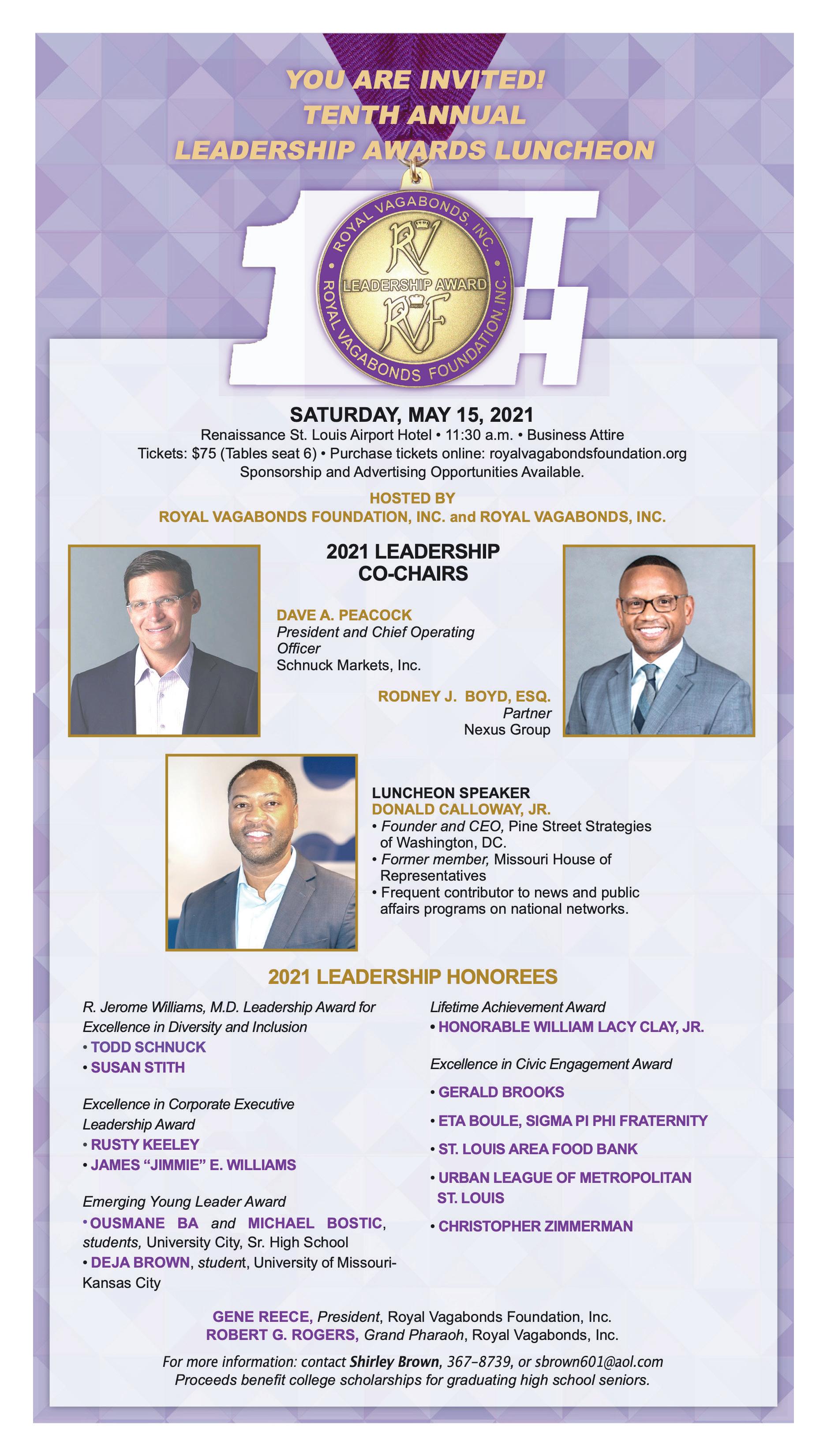






Nila Johnson has been in the healthcare/pharmaceutical industry for almost three decades and worked for companies like Mallinckrodt and Express Scripts. Johnson is passionate about stopping the spread of misinformation about COVID-19.

Sylvester Brown, Jr.
Of The St. Louis American
“Black people can’t die from COVID-19.”
“The virus was man-made for the purposes of population control.”
“The virus can be contained through herbal remedies.”
“5G radiation is the root cause of COVID19.” These were some of the theories circulating predominantly through social media a year ago when the coronavirus began spreading throughout America. The misinformation coming from, and aimed at, Black people was so intense that actor Idris Elba felt compelled to address the issue live on social media:
“My people, Black people, please understand [about] coronavirus: you can get it,” Elba said after contracting the disease in March last year. “There are so many stupid, ridiculous conspiracy theories about black people not being able to get it. That’s dumb, that’s stupid. That’s the quickest way to get more Black people killed.” Black Americans have been disproportionately impacted by the coronavirus.
According to a March 5, 2021 report by AMP Research Lab, of the more than 540,000 deaths in the U.S., more than 73,000 have been Black people. The “fake news” regarding COVID-19 has medical experts very concerned. Recently, the Annenberg Foundation hosted a webinar
titled, “Covering Coronavirus: Fighting the Infodemic.”
In promoting the webinar, organizers wrote: “The potentially fatal dangers posed by the ‘infodemic’ are especially acute in communities of color, where long histories of racism and medical mistrust combined with a lack of trusted messengers have paved the way for COVID-19 misinformation and vaccine skepticism.”
Nila Johnson is familiar with the misinformation that’s been circulating in Black communities. Johnson has been in the healthcare / pharmaceutical industry for almost three decades as an executive and as an outreach
See MISINFORMATION, A17
By Dana Sparks Mayo Clinic staff
Some prescription and over-the-counter medications, as well as supplements and other substances, can raise your blood pressure. Certain ones can also interfere with medications intended to lower your blood pressure. Here are some medications, supplements and other substances that can increase your blood pressure. If you’re using any of these substances and are worried about the effect it could have on your blood pressure, talk to your healthcare provider.
Certain pain and anti-inflammatory medications can cause you to retain water, creating kidney problems and increasing your blood pressure. Examples include:
• Indomethacin (Indocin, others)
• Acetaminophen (Tylenol, others)
• Aspirin, naproxen sodium (Aleve, Anaprox) and ibuprofen (Advil, Motrin IB, others)
• Piroxicam (Feldene)
Have your blood pressure checked regularly. Talk to your healthcare provider about which pain medication is best for you. If you must continue taking a pain medication that raises your blood pressure, your provider may recommend lifestyle changes or additional medication to control your blood pressure.
Antidepressants work by changing your body’s response to brain chemicals, including serotonin, norepinephrine and dopamine, that affect your mood. These chemicals may also cause an increase in blood pressure. Examples of antidepressants that can raise your blood pressure are:
• Venlafaxine (Effexor XR)
• Monoamine oxidase inhibitors
• Tricyclic antidepressants
• Fluoxetine (Prozac, Sarafem, others)
If you take antidepressants, have your blood pressure checked regularly. If your blood pressure increases or isn’t well-controlled, ask
See BLOOD PRESSURE, A17
By Laura Ungar Kaiser Health News
Alexandra Sierra carried boxes of food to her kitchen counter, where her 7-year-old daughter, Rachell, stirred a pitcher of lemonade.
“Oh, my God, it smells so good!” Sierra, 39, said of the bounty she’d just picked up at a food pantry, pulling out a ready-made salad and a container of soup. Sierra unpacked the donated food and planned lunch for Rachell and her siblings, ages 9 and 2, as a reporter watched through FaceTime. She said she doesn’t know what they’d do without the help. The family lives in Bergen County, New Jersey, a dense grouping of 70 municipalities opposite Manhattan with about 950,000 people whose median household income ranks in the top 1% nationally. But Sierra and her husband, Aramon Morales, never earned a lot of
St. Charles County has seen an increase by 69%
n The financial fallout of covid19 has pushed child hunger to record levels. The need has been dire since the pandemic began and highlights the gaps in the nation’s safety net.
money and are now out of work because of the pandemic. The financial fallout of covid-19 has pushed child hunger to record levels. The need has been dire since the pandemic began and highlights the gaps in the nation’s safety net. While every U.S. county has seen hunger rates rise, the steepest jumps have been in some of the wealthiest counties, where overall affluence obscures the
See CHILD HUNGER, A17

By Caroline Gutman of KHN
A volunteer prepares food packages for distribution at the Center for Food Action in Englewood, New Jersey, on March 9, 2021.


Continued from A16
tenuous finances of low-wage workers. Such sudden and unprecedented surges in hunger have overwhelmed many rich communities, which weren’t nearly as ready to cope as places that have long dealt with poverty and were already equipped with robust, organized charitable food networks.
Data from the anti-hunger advocacy group Feeding America and the U.S. Census Bureau shows that counties seeing the largest estimated increases in child food insecurity in 2020 compared with 2018 generally have much higher median household incomes than counties with the smallest increases. In Bergen, where the median household income is $101,144, child hunger is estimated to have risen by 136%, compared with 47% nationally. That doesn’t mean affluent counties have the greatest portion of hungry kids. An estimated 17% of children in Bergen face hunger, compared with a national average of around 25%. But help is often harder to find in wealthier places. Missouri’s affluent St. Charles County, north of St. Louis, population 402,000, has seen child hunger rise by 69% and has 20 sites distributing food from the St. Louis Area Foodbank. The city of St. Louis, pop. 311,000, has seen child hunger rise by 36% and has 100 sites.
“There’s a huge variation in how different places are prepared or not prepared to deal with this and how they’ve struggled to address it,” said Erica Kenney, assis-
Continued from A16
your healthcare provider about alternatives to these medications.
Hormonal birth control
Birth control pills and other hormonal birth control devices contain hormones that may increase your blood pressure by narrowing smaller blood vessels. Nearly all birth control pills, patches and vaginal rings come with warnings that high blood pressure may be a side effect. The risk of high blood pressure is greater if you’re older than age 35, overweight or a smoker. Not all women will have increased blood pressure from using hormonal birth control. But if you’re worried, have your blood pressure checked at least every six to 12 months. If you already have high blood pressure, consider using a different form of birth control. While nearly all birth control pills can raise your blood pressure, your blood pressure may be less likely to increase if you use a birth control pill or device that contains a lower dose of estrogen.
Continued from A16
coordinator for pharmaceutical companies like Mallinckrodt and Express Scripts. Although the “infodemic” is hard for her to tolerate, Johnson said she welcomes family and friends who come to her for advice or counsel on the pandemic and coronavirus vaccinations.
“Listen, I get it. We’ve had the Tuskegee experiment and all kinds of negative experiences in hospitals and in the military. I’ll give you a mulligan on that,” Johnson explained. “But the problem I have is when we start feeding into our own conspiracy theories, when
tant professor of public health nutrition at Harvard University. “The charitable food system has been very strained by this.”
Eleni Towns, associate director of the No Kid Hungry campaign, said the pandemic “undid a decade’s worth of progress” on reducing food insecurity, which last year threatened at least 15 million kids.
And while President Joe Biden’s covid relief plan, which he signed into law March 11, promises to help with anti-poverty measures such as monthly payments to families of up to $300 per child this year, it’s unclear how far the recently passed legislation will go toward addressing hunger.
“It’s definitely a step in the right direction,” said Marlene Schwartz, director of the Rudd Center for Food Policy and Obesity at the University of Connecticut. “But it’s hard to know what the impact is going to be.”
Need grows in places of plenty
After the pandemic struck, the federal government boosted benefits from the Supplemental Nutrition Assistance Program and offered Pandemic Electronic Benefit Transfer cards to compensate for free or reducedprice school meals while children were schooled from home.
Sierra’s family saw their SNAP benefits of about $800 a month rise slightly and got two of those P-EBT payments, worth $434 each. But at the same time, they lost their main sources of income. Sierra had to leave her
Caffeine
About 200 to 300 milligrams of caffeine can cause a temporary spike in blood pressure.
Caffeine blocks a hormone that keeps your blood vessels open, allowing blood to easily pass through. This may temporarily increase blood pressure. It also may cause you to produce more cortisol and adrenaline, which speeds up blood flow, causing a spike in blood pressure. However, there isn’t enough evidence to prove that caffeine raises your blood pressure long term.
Examples of caffeine-containing medications and products include:
• Caffeine pills (Vivarin, others)
• Coffee • Energy drinks and other beverages
The caffeine content of coffee can vary widely, so it’s difficult to say how many cups of coffee you can drink a day. In addition, some studies suggest that coffee may contain a substance that lowers blood pressure, thus counteracting any stimulating effects.
To see if caffeine raises your blood pressure, check your blood pressure about 30 minutes after drinking a cup of coffee or another caffein-
we create this unbreakable circle.”
In June 2020, Brandi Collins-Dexter, a visiting fellow at the Harvard Kennedy School’s Shorenstein Center and a senior fellow at Color Of Change, published “Canaries in the Coal Mine: COVID-19 Misinformation and Black Communities.” Tracking misinformation since the beginning of the crisis, Collins-Dexter reported that the Black online community was “awash in medical misinformation” even as Blacks were disproportionately dying from the virus. This is the major point Johnson emphasizes when she discusses COVID-19: “First, let’s deal with some facts. We’re disproportionately
Amazon warehouse job when the kids’ school went remote, and Morales stopped driving for Uber when trips became scarce and he feared getting covid on top of his asthma.
Federal relief wasn’t enough for them and many others. So they flocked to food pantries.
In theory, pantries and the food banks that supply them are part of an emergency system designed for short-term crises, Schwartz said. “The problem is, they’ve actually become a standard source of food for a lot of people.”
In Bergen County, the Center for Food Action helped 40,500 households last year, up from 23,000 the year before.
In Eagle County, Colorado, where the tony ski resort Vail is located, the Community Market food bank saw its client load nearly quadruple to 4,000. And outside Boston, in the affluent Massachusetts county of Norfolk — where Feeding America data shows child hunger jumped from an estimated 6% of kids to 16% — Dedham Food Pantry’s clients tripled to 1,800.
“This is just out of control compared to other times,” said Lynn Rogal, vice president of the Dedham pantry, which opened in 1990.
Pantry managers said a disproportionate number of clients are from minority groups. Many lost jobs in the eviscerated service sector that undergirds the wealthier parts of their counties. Julie Yurko, CEO of the Northern Illinois Food Bank, said up to half of her current clients have never sought help before.
“In early January, we had a white minivan pull up with three kids, 5 and younger. It ran out of gas sitting there,” Yurko said. “The mom was
ated beverage. If your blood pressure goes up by five to 10 points, you may be sensitive to the blood pressure raising effects of caffeine.
Cold medicines (decongestants)
Decongestants narrow your blood vessels, which makes it harder for blood to flow through them, increasing blood pressure. Decongestants may also make some blood pressure medications less effective. Examples of decongestants are:
• Pseudoephedrine (Sudafed, Sudogest)
• Phenylephrine (NeoSynephrine)
Check the label of your cold or allergy medication to see if it contains a decongestant. If you have high blood pressure, it’s best to avoid decongestants. Ask your health care provider or pharmacist about over-the-counter cold products made for people who have high blood pressure.
Herbal supplements
Remember to tell your healthcare provider about any herbal supplements you take or are thinking about taking, to see if the supplement could raise your blood pressure or interact with blood pressure
dying from this disease. And that’s because we’re pulling up the rear on health issues like diabetes, high blood pressure and obesity and a host of other socio / economic reasons,” Johnson stressed. “So, it should come as no surprise that when the disease hit our shores, it would hit us super hard. It’s not just the culture, we’ve always come up last when it comes to healthcare. Now we need to talk about how we’re going to get better.”
Johnson said she’s also heard or read speculations and fears online about the COVID19 vaccinations. Some of the most popular misconceptions are that vaccines increase the risk of autism or catching the coronavirus; vaccines can
sobbing, and her beautiful children were sitting there watching her.”
Kelly Sirimoglu, spokesperson for New Jersey’s Center for Food Action, said the stigma around seeking help can be worse in wealthy areas. She said some people tell her, “I never thought I would be in line for food.”
Advocates said the reluctance to seek help means the need is likely even larger than it appears.
Katie Wilson of St. Charles, Missouri, said she heard about a food pantry run by the Sts. Joachim & Ann Care Service from a friend of a friend. She almost didn’t go. The single mom of two children, 11 and 9, lost her job as a hotel auditor in June and tried to squeak by without her income for two months.
“We found ourselves in a situation where it was a ‘heat or eat’ kind of thing,” said Wilson, 42, describing having to choose between heating her home or buying food. “It took me looking around and saying, ‘There is nothing to eat.’”
Struggling to meet the need
As hunger has become more visible, donations to food charities have risen. But they don’t address the core problem of an infrastructure that doesn’t match the new need. Some pantries are open just a few hours a week in church basements, a far cry from those that operate regularly and look like supermarkets. Many small pantries struggled to shift to outdoor food distribution during the pandemic or find new helpers when the few, often senior, volunteers felt unsafe doing the work.
medications. Examples of herbal supplements that can affect your blood pressure or blood pressure medications include:
• Arnica (Arnica montana)
• Bitter orange (Citrus aurantium)
• Ephedra (ma-huang)
• Ginseng (Panax quinquefolius and Panax ginseng)
• Guarana (Paullinia cupana)
• Licorice (Glycyrrhiza glabra)
• St. John’s wort (Hypericum perforatum)
Herbal supplements aren’t necessarily safe just because they’re natural. Check with your healthcare provider before taking any herbal supplements. You may need to avoid supplements that raise your blood pressure or interfere with your blood pressure medications.
Biological therapies
Powerful drugs used in biological therapies can have side effects, including high blood pressure. Some of these drugs target specific cells, and some use your body’s own immune system to fight a variety of autoimmune diseases and cancers.
Angiogenesis inhibitors in particular and some mono-
overload the immune system; vaccines are used to microchip people; and even, Black people aren’t getting the same vaccinations as white Americans.
Johnson always advocates a fact-based approach, urging people to also use the internet to fact-check false or misleading claims. She’s debated people who are suspect of how quick the country came up with a vaccine for the virus:
“Many people don’t realize that research and development on related viruses was already in process, that’s why they were able to come up with a vaccine so quickly.”
When asked about the fears of different vaccines for different races, Johnson flatly declared it as “nonsense”:
“It definitely is harder in these places,” said Yurko, whose food bank distributes to Kendall County, Illinois, which has just three pantries for its population of 129,000. “The safety nets are not as robust.”
A strong safety net also requires pantries to cooperate with one another and the broader array of local social services. That’s been happening for years in Flint, Michigan, said Denise Diller, executive director of Crossover Downtown Outreach Ministry, which runs a pantry. Agencies and community leaders banded together in 2014 when lead poisoned the drinking water.
“When covid occurred, we were already kind of ready,” Diller said.
So was Atlanta. As in Flint, hunger was never hidden there; 15% of children in Fulton County, which includes Atlanta, faced hunger before the pandemic. After covid suspended volunteer shifts, the Atlanta Community Food Bank asked the Georgia National Guard to help sort, pack, warehouse and deliver food to help meet the needs of the estimated 22% of kids experiencing hunger. The food bank also partnered with seven school districts on more than 30 mobile pantries.
Such coordination and connections were lacking in Bergen County, where 80 pantries worked mostly in isolation when the pandemic hit, County Commissioner Tracy Zur said. “They weren’t collaborating. They were going along the same path they had for decades,” she said. “There was this need to break out of the old way of doing things and work together to be more
clonal antibodies can cause an increase in blood pressure.
Examples of these drugs include:
• Bevacizumab (Avastin, Mvasi)
• Gefitinib (Iressa)
• Imatinib (Gleevec)
• Pazopanib (Votrient)
• Ramucirumab (Cyramza)
Immunosuppressants
These drugs are given to nearly everyone who’s had an organ transplant. Some immunosuppressants can raise your blood pressure, possibly because of the ways immunosuppressants can affect your kidneys. Examples of immunosuppressants that can increase your blood pressure include:
• Cyclosporine (Neoral, Sandimmune, Gengraf)
• Tacrolimus (Astagraf, Prograf, Envarsus XR)
Have your blood pressure checked regularly. If your blood pressure increases or isn’t well-controlled, ask your healthcare provider about alternatives to these medications. Your provider may recommend lifestyle changes or additional medications to control your high blood pressure.
Stimulants
Stimulants, such as methyl-
“I rely on my professional and personal expertise,” Johnson responded. “First, let’s look at supply & demand. The supply is not keeping up with demand. Companies are trying to produce as much as they can as quickly as they can for everybody, be they Black, white, or purple. Do you really think they’ve got time to deliver vaccines based on race?”
Johnson compares a lot of modern-day fears regarding the pandemic and vaccinations to other pandemics like polio in the 1950s and AIDs in the 1980s.
impactful.”
Zur spearheaded the creation of a food security task force in July, reaching out to municipal and faith leaders. Goals include feeding people, connecting them to other services and turning some emergency food programs into fullfledged pantries. “Building an infrastructure is painstaking and ongoing,” she said. Now, Zur said, pantries are starting to share with one another when one gets a large donation of perishable items such as eggs or milk. With the need so widespread, residents do much the same.
During a recent pantry trip, Sierra, the New Jersey mom, opened the trunk of her 1999 Toyota and rummaged through the two big boxes volunteers had just placed there. She pointed to eggs, chicken, bread, butter, cheese and apples, observing, “I have more than I need.” But she said it would never go to waste. Any extra would go to neighbors and their hungry children.
KHN (Kaiser Health News) is a national newsroom that produces in-depth journalism about health issues. Together with Policy Analysis and Polling, KHN is one of the three major operating programs at KFF (Kaiser Family Foundation). KFF is an endowed nonprofit organization providing information on health issues to the nation.
Midwest correspondent Cara Anthony and data editor Elizabeth Lucas contributed to this story.
Edited for length / To read full story go to https://tinyurl. com/s58cz349
phenidate (Ritalin, Concerta, others), can cause your heart to beat faster or irregularly, raising your blood pressure. Have your blood pressure checked regularly if you take a stimulant. If your blood pressure increases or isn’t well-controlled, ask your health care provider about alternatives to these medications. He or she may recommend lifestyle changes or additional medications to control your high blood pressure.
A caution on illegal drugs
Illegal drugs can raise blood pressure by narrowing the arteries that supply blood to your heart. This increases your heart rate and damages your heart muscle. Examples of illegal drugs that can affect your heart include:
• Amphetamines, including methamphetamine • Anabolic steroids • Cocaine If you’re using illegal drugs, it’s important to stop. Ask your healthcare provider for information on counseling or drug treatment programs. For more information, visit mayoclinic.org.
Reprinted with permission.
“I remember as a little girl when they vaccinated the whole class for polio. Some of the same fears and talking points today were circulating about the AIDS virus. People were saying it was man-made disease created to decrease the African population and so forth. It wasn’t a Black or white issue back then. Now, people can live with AIDS. And that’s because of research and development.”
Johnson said the concerns she hears from family and friends about COVID-19 or vaccinations her comments end on the same note:
“I tell them, ‘a healthy country is a wealthy country.’ It goes beyond race. This country can’t survive without its worker bees. The federal government is providing vaccination services for free. We all need to get vaccinated to get this thing under control. So, do it!”



Nutrition Challenge:


When we’re lucky enough to have a chance to go out for dinner, there are a few ways to stay healthy with our food

















Calculate BMI

See if the restaurant will let you “share” a meal. Many meals are two, three or more times an actual serving size.
fruits and vegetables will begin to come into season. What are your favorites? First make a which
We each need at least 3 servings per day of whole grains. But what does that mean? How can we know what foods contain whole grains?
In our “Super-Size” world, we can easily lose track of what an actual serving size means. When reading labels on a food or drink product, you can determine the nutrients, sodium, fiber, sugar and calories of a serving size. But be careful; just because it looks like one small bottle
Look at the ingredients list of a package of food you are about to eat. If the word “whole” is used, then there is most likely a whole grain ingredient. A few items that don’t use the word whole
As soon as you’ve divided your plate into the right size servings, ask your server for a to-go box. Go ahead and box up what you don’t need to eat right away. You can enjoy
If you injure yourself while exercising (or even just walking around), an ice pack is usually one of the best ways to treat the initial pain and swelling. Talk to a nurse or doctor about your injury if the pain is severe, or if you don’t feel better within
As spring approaches, warmer weather allows us all to get more outdoor exercise. Here are some ways to become a more active person.
It’s important that before you embark on any kind of exercise to remember two things: warm up and cool down. Start with some slow stretches and movement (like walking) to increase your heart rate a little. Warm up for a good five minutes before increasing your heart rate.
those leftovers for lunch the next day!
> Ask the server how the different menu items are prepared. Fried, sautéed, and
of these fruits and vegetables provide the most
are popcorn, wheatberries, brown rice and wild rice.
Getting plenty of whole grains in your diet can improve your health and reduce your chance for some chronic illnesses such as stroke, diabetes, heart disease and high blood pressure. Visit wholegrainscouncil.com for more information.
even simmered can all mean, “cooked in oil.” Instead, choose baked or grilled options.
example, a
> Avoid gravies, cheese sauces and other kinds of toppings that often just add fat and calories.
nutritional benefit. Some things you could watch for are lower sugar content, high fiber, vitamins, etc. Pick your top four fruits and vegetables based on your findings
March 20, 2021, is the first day of spring. With spring comes warmer weather and longer days (later sunset). Make it a habit to spend as much time playing outside as the weather allows.
and try to eat at least one of these each day.
Learning Standards: HPE 2, HPE 5, NH 1, NH 5
bottle contains 2.5 servings. So if the bottle states “110 calories per serving,” that means the entire bottle contains a total of 275 calories! Remember to watch those serving sizes and you’ll have better control over what you’re eating and drinking.
Latoya Woods, DNP, APRN, FNP-C
> Stick with water to drink. Not only will you save money, but you won’t be adding in extra calories from a sugarfilled drink.
Learning Standards:
Learning Standards: HPE 2, HPE 5, NH 1, NH 3, NH 5
Secondly, when you are finished with any kind of strenuous (very active) exercise, take some time to cool down. You can slowly stretch your arms and
a day or two. Let him or her know what you were doing when you first felt the pain.
Instead of playing video games — play baseball, football, badminton, or some other active game.
> What are other ways to stay healthy while dining out?
Learning Standards: HPE 1, HPE 2, HPE 5, NH 1, NH 5



Where do you work? I am a family nurse practitioner for BJC Medical Group.
Where do you work? I am the founder and distance counselor for Goal Driven Counseling, LLC.
Where do you work? I work at St. Louis Children’s Hospital on the Behavioral Health Unit.
Where do you work? I am a school nurse at Monroe Elementary School.
for a while, follow the doctor’s orders. Sometimes you just need to let your body heal. Pushing yourself before you’re ready could actually cause your body to take even longer to mend itself and feel better.
legs again, and continue with reduced speed movements until your heart rate begins to slow down.
and breathing. You want to have fun, but it’s also a great way to help keep your heart, lungs and body healthy.
Instead of watching TV — ride your bike with friends. Can you think of other ways to be more active? Going outside and staying active not only increases your heart rate and burns calories, but it also helps you build friendships!
If you’re told to “take it easy”
Learning Standards: HPE 2, HPE 7, NH 7
This warm-up and recovery period is important for your heart health. It also helps to reduce the amount of muscle pulls and strains.
Learning Standards:
Where did you go to school? I graduated from Sumner High School. I then earned Associate Degree in Nursing from Forest Park College and a BS in Business Administration from Columbia College.
Where did you go to school? I graduated from McCluer High School. I then earned a Bachelor of Nursing and a Master of Nursing Practice from the University of Missouri – St. Louis. And finally, I earned a Doctorate of Nursing Practice from Maryville University.
Where did you go to school? I graduated from Whitney Young Magnet High School in Chicago, IL: same as former first lady Mrs. Michelle Obama. I then earned a Bachelor of Science in Social Work, and a Master of Social Work from the University of Missouri – St. Louis. I also completed two more years of supervision and exams to become a Licensed Clinical Social Worker in the state of Missouri.
Where did you go to school? I graduated from Sumner High School. I then earned an LPN from St. Louis College of Health Careers, an ASN from Deaconess College of Nursing, a BSN from Webster University, an MSN from Maryville University, and I’m currently completing my PNP from Maryville University.
Some fun outdoor games to play include tag, kickball, basketball, Frisbee, and bicycling. Choose activities that increase your heart rate
Instead of surfing the ‘Net — go for a brisk walk around the neighborhood.
Two kinds of listening are passive and active. An example of passive listening is when you are doing your homework and you have a TV show on in the background. You probably don’t even know what they’re saying on the TV, but you certainly can hear it.
> NEVER walk on a “frozen” pond, lake, river or any other body of water. Just because it looks frozen does not mean it is safe.
Break into small groups and define what it means to be a bully. Share your ideas with the class. Did you have the same things listed (as the other groups) that you would consider as bullying behavior? Now back in your groups, create a newspaper ad that includes at least two of the following:
Make a list of your favorite 10 activities to do outdoors. Compare your list with your classmates and create a chart to see what are the most popular.
HPE1, HPE 2, HPE 5, NH 1, NH 5
reacting physically (like nodding).
Learning Standards: HPE 2, HPE 5, NH 1
Learning Standards: HPE 1, HPE 2, HPE 5, NH 1
> What to do if you see someone else bullied.
What does a family nurse practitioner do? Each day I have office visits with patients to help treat new health conditions and/or manage established health conditions. I perform physical examinations on patients, order labs, read x-rays results, and more.
What does a Licensed Clinical Social Worker do? I use technology to help teens and young adults explore their emotions, better understand their feelings, work through relationships, and address common challenges completely online through a computer, tablet, or smart phone. Similar to a Facetime call, I support and guide my clients from the comfort of their home or private location where they are comfortable
A BMI (Body Mass Index) is a generic way to calculate where your weight falls into categories (thin, average, overweight, obese). However, it’s a good idea to remember that a BMI may not take into consideration many things such as athleticism (how athletic you are), your bone density and other factors. Discuss your BMI with your
Active listening requires you to pay attention to the person that is speaking. You can improve your active listening by asking questions, taking notes and
> If you are with someone that falls through the ice, first run (or call) for help. Do not try to go out onto the ice to help your friend. You can fall through the ice too.
> How bullying hurts others.
> What to do if you are bullied.
> When walking on icecovered roadways or sidewalks, take baby steps. Walk carefully and slowly.
Effective listening will improve your grades at school and it can also make a difference in your relationships with family and friends.
doctor if you have any questions. The formula to calculate your BMI is 703 X weight (lbs) ÷ height (in inches/squared) or search “BMI Calculator” to find an easy fill-in chart online. If your number is high, what are some ways to lower your BMI?
> What to do if YOU are the bully.
Look through the newspaper for examples of ad layouts and design. Discuss the words “compassion,” “empathy” and “sympathy.” How do they each play into your response to bullying at your school?
> Also — remember to look up! Icicles injure numerous people every year. If you see large icicles forming over your front steps, ask your parents to use a broom handle to knock them off to the side before they break loose from your gutters.
> What other ice hazards are there?
Learning Standards: HPE 1, HPE 2, NH 5
As a class, discuss what it feels like when someone isn’t really listening to you. How can you show that you’re actively listening while your friend is speaking?
Learning Standards: HPE 2, HPE 5, NH 4
Learning Standards: HPE 2, HPE 5, HPE 7, NH 5, NH 7
“Questions or comments? Contact Cathy Sewell csewell@stlamerican.com or 314-289-5422
Learning Standards: HPE 2, HPE 4
Ingredients:
1 Whole-grain bagel
2 Tbsp Low-fat Cottage cheese
½ Cp Sliced Strawberries (or other fruit)
Directions: Spread the cottage cheese onto a toasted bagel. Top with strawberries or other fruit.
Directions: Blend all ingredients until Smooth. Makes 2 yummy smoothies!
Directions: Spread peanut butter on four of the crackers and top with sliced strawberries. Drizzle with honey and top with the other crackers to make four cracker-wiches.
What does an RN with an MSN do? I go to the homes of children with special needs and interact with them to see how they are progressing with the skilled nursing services that are being provided in their homes. Some children require nursing to attend school.
Why did you choose this career? I chose this career to help improve the health of my community.
What does a school nurse do? I assess the concerns of students who are ill, injured or experiencing alterations in their normal health. Nurses screen daily staff, students and visitors for safety. Monroe School is a pilot school for Covid-19 test sites in partnership with the city. Why did you choose this career? I love nursing because there are many opportunities in hospitals, schools, clinics and offices, insurance, legal and research. My passion is working in the schools with students, parents, staff and community partners.
“Questions or comments? Contact Cathy Sewell csewell@stlamerican.com or 314-289-5422 Easy Hummus
Why did you choose this career? I chose this career because I enjoy being a support to teens and young adults in a very challenging phase of life that can be overwhelming. I enjoy teaching them how to best take care of themselves so they can live healthy and fulfilling lives.
Why did you choose this career? I chose to become a nurse because I love caring for children. I enjoy helping them become and stay healthy. My oldest daughter was born very sick. I watched as the nurses in the neonatal intensive care unit nursed her back to health and I knew then, this was something I was meant to do.
What is your favorite part of the job you have? Many chronic health conditions (diabetes, high cholesterol, high blood pressure) are preventable, and early detection is key. Thus my favorite part of the job is partnering with patients to establish and manage a plan to help them each live a long and healthy life.
What is your favorite part of the job you have? I enjoy when a child tells you, “I want to be a nurse.” And best of all, I love the smiles, hugs and “thank-yous”.
Learning Standards: HPE6, NH3
What is your favorite part of the job you have? The best part of my job is seeing my healthy patients years later and they still recognize me as the nurse that helped them when they were sick. I can honestly take a trip to Wal-Mart right now and run into a kid I used to service and they will say, “Hi nurse.” I love it.
What is your favorite part of the job you have? I love that my job makes talking about mental health not as scary and even makes it kind of cool. I love that I get to build valuable relationships with so many people that trust me to be there for them. I love that no matter where my clients are, we can simply connect with a video call and I can not only support them through hard times, but lots of good times as well.
Learning Standards: HPE6, NH3
Learning Standards: HPE6, NH3
Learning Standards: HPE6, NH3
“Questions or comments? Contact Cathy Sewell csewell@stlamerican.com or 314-289-5422
“Questions or comments? Contact Cathy Sewell csewell@stlamerican.com or 314-289-5422







The St. Louis American’s award winning NIE program provides newspapers and resources to more than 8,000 teachers and students each week throughout the school year, at no charge.

Local students conduct selfdirected research in order to complete a challenging science activity, using the resources provided by The St. Louis American.


The American Optometric Association (eye doctors) researched this topic and here is what they discovered: 3D movies, TV shows, and games are safe for children age 3 and above.
Reusable 3D glasses can contain harmful bacteria.
Use anti-bacterial wipes as a precaution.
Time spent playing handheld games that are held close to the face should be limited, with frequent breaks, to rest the eyes.
Although there was concern that 3D movies can trigger a

Background Information:
In this experiment, you will surprise your eyes by creating an optical illusion to see which arrow is longer.
Materials Needed:
• Pipe Cleaners (2 different colors, same length)
• Scissors Process:
q You will need two pipe cleaners that are the same length and color. These pipe cleaners will be the body of the arrows.
w Create the ends of your arrow by cutting in half two other pipe cleaners that are a different color.
e Wrap the end of one long pipe cleaner around the middle of one short pipe cleaner. Then bend the short one in half so it looks like an arrow. Do the same thing with the other end. The ends will point outward.

Answer these questions about movies.
z The cost of tickets for a play is $6.00 for adults and $4.00 for children.
350 tickets were sold and $950 was collected. How many tickets of each type were sold? ______
x You are having a movie marathon. Each movie lasts an average of 110 minutes. You have rented 3 movies. How long will the movie marathon last?

seizure, the AOA has discovered that there is only a risk for seizure if the person has photosensitive epilepsy or is taking certain medications.
3D glasses work by viewing a different image in each eye. Some people are unable to see 3D effects if they have a “stereo deficiency.” So, thanks to 3D technology, some people have been able to detect vision issues and get them corrected.
Learning Standards: I can read nonfiction text for main idea and supporting details.
r Then wrap the end of the other long pipe cleaner around a short pipe cleaner, but this time, turn the arrows inward.
t Move your pipe cleaners apart... Now you have an optical illusion! Even though the two long pipe cleaners are the same length, one of them should look shorter than the other.
Check out these optical illusions online: http://www. kidsmathgamesonline.com/pictures/ illusions.html.
Learning Standards: I can follow sequential directions to complete an experiment. I can analyze results and draw conclusions.
c A movie theater sells tickets for $9.00 each. Senior citizens receive a discount of $3.00. One evening the theater sold 636 tickets and took in $4974 in revenue. How many tickets were sold to senior citizens? How many were sold to “moviegoers” who were not senior citizens? ______
v Aaron’s family is going to see a movie at 5:50 p.m. It is 11:20 a.m. right now. How long do they have to wait to see the movie? hours ______ minutes
Columbia Pictures was the first big studio to make the 3D movie Man in the Dark (1953).
b A movie that began at 6:15 p.m. ends at 8:05 p.m. How long did it last? ______ hours ______ minutes
Learning Standards: I can add, subtract, multiply, and divide to solve a problem. I can think critically. I can make text-to-world connections.
opening weekend was Star Wars: The Force Awakens (2019) which grossed about $248 million in the US on its first 3 days of showing. The most expensive 3D movie to create was Avatar, which cost almost $480 million to create.


Marc Hannah was born in Chicago, Illinois, on October 13, 1956. He always enjoyed math and science in school. In high school, he sparked an interest in computer technology. With a scholarship, he attended the Illinois Institute of Technology where he earned his bachelor's degree in electrical engineering. Hannah then went to Stanford University to earn his master’s and doctorate degrees in Electrical Engineering.
In 1982, Hannah and six other people founded Silicon Graphics Incorporated (SGI). SGI computers are used to design airplanes and automobiles, as well as engineering, research, and military applications. However, a very popular use is creating special effects in television and movies. Hannah helped create special effects in Terminator 2, Jurassic Park, Aladdin, Forrest Gump, The Hunt for Red October, Beauty and the Beast, and Fields of Dreams. SGI computer graphics are also used in music videos, such as Michael Jackson’s video “Remember the Time.”
Hannah is currently chief technology officer for SongPro, which creates multimedia plug-ins for hand held video games and portable music devices. He is a director and co-founder of Strategic Urban Development Alliance (SUDA), which is an engineering, construction, real estate, and finance firm. Hannah also serves on the board of directors for Magic Edge, which creates technology used in amusement parks.
In addition to his 15 patents, Hannah was given many awards, including the Kilby Young Innovator Award, Black Engineer of the Year Technical Contribution Award, IIT Alumni Association Professional Achievement Award, NTA Professional Achievement Award, San Francisco Black Chamber of Commerce Front Runner Award, M.E.N.T.O.R. Network Technology Award, and M.O.B.E Influencers & Innovators Award. Hannah has also been featured in Ebony magazine, Electronics magazine, Forbes, and PC Magazine.
Hannah is quoted as saying, “My job is to look ahead two to three years and see what’s coming. To see what consumers want, what they will want, and then to figure out how we can deliver that—at what price.”
Learning Standards: I can read biographical information about a person who has made a contribution in the fields of science, technology, engineering, and math. I can make text-to-text connections, text-to-world connections, and text-to-self connections.

Enjoy these activities that help you get to know your St. Louis American newspaper.
Activity One — Technology in our Community: New technology continuously changes the way we do things. Use the newspaper to locate a picture of an invention that has affected or changed your life in some way. Write about how the invention has changed your life.


Activity Two — Mystery Story: Each student will cut out several pictures from the newspaper without reading the captions. Place the pictures in a bag, and without looking, pick your mystery picture from the bag. That’s your stimulus for writing.
Create a graphic organizer for the 5Ws (who, what, where, when, why) and continue the writing process.
Learning Standards: I can locate information in a newspaper. I can write for a specific purpose and audience. I can make text to self and text-to-world connections.


By Danielle Brown Of the St. Louis American
Early on, dance was the quintessential piece in Sabrina McField’s existence; she ate, breathed, and slept it like her life depended on it.
At 18, it was her dream career; now at 35, she realizes it was the refuge that helped her cope with the childhood trauma she experienced during her parent’s dysfunctional marriage. Her book, “The Dance in My Shoes: Ten Power Moves to Make Life Move to Your Rhythm,” provides readers with a widened lens on the effect her upbringing had on her, especially when following her dreams in Los Angeles. It also dives into how she forgave her parents for their mistakes.
Before her big move, she sought guidance and mentorship from Anthony ‘Redd’ Williams, established choreographer and creative director who persuaded her decision.
“I remember her telling me I think I wanna dance and I said go for it,” Williams said. “I’ll never forget I received a call from her saying that she moved to LA. She made that jump and that was the start.”
Her now divorced parents Denise McField and Robert McField were skeptical about her relocation to a new city. Ultimately, they agreed it was best for her to make her own decisions.
“I didn’t like it at all, but I knew she had a passion for dance, so I had to trust the process,” Denise said. “I didn’t want to feel guilty that I had inhibited her natural ability.”
The grind was real for McField while in LA, she was blessed to share the stage with R. Kelly, Nelly, Keyshia Cole, and more. Most assumed

McField’s new book “The Dance In
Life Move to Your Rhythm,” provides deeper insight into
ration in regards to childhood trauma.
she was living the good life because she was photographed with celebrities and attending some of the hottest events at the time.
But it was the opposite. She felt lonely as she slept on her friend’s hardwood floor with no money, food, or family support.
“While everybody was thinking Sabrina got it, I was struggling, but I was fighting too. I wasn’t giving up on myself. I cried every night
in LA.” said McField.
She had an epiphany that made her realize the why behind her move to LA wasn’t her dreams after all, it was to escape her harsh reality of unconfronted childhood trauma.
“Dancing next to a celebrity, opening up
See Dancer, B8

Missouri-born Civil Rights warrior C.T. Vivian tells his story in posthumous memoir
By Sarah Fenske St. Louis Public Radio
The Rev. C.T. Vivian, the Missouri-born preacher who served as a civil rights leader and confidant to the Rev. Martin Luther King Jr., died last year at age 95. Now, eight months later, Vivian’s posthumously published memoir brings the full scope of his long life and landmark battles to life. That includes successful efforts to desegregate lunch counters in Nashville and Peoria, Illinois; beaches in St. Augustine, Florida; and interstate bus lines as a Freedom Rider. Vivian was punched by the notorious Sheriff Jim Clark on the courthouse steps in Selma, Alabama, assaulted in jail and nearly drowned during the St. Augustine “wade-in.” His coolness in the face of violence led Andrew Young to credit his Selma interactions as directly leading to the Voting Rights Act. But for Vivian, it all began in Boonville, Missouri, and then Macomb, Illinois, where he moved at age 6 and always thought of as home. “As he was in his final hours, he said, ‘I loved
See Memories, B2
By Danielle Brown
Of the St. Louis American
From job losses, to COVID-19 related deaths to heightened anxiety and depression, 2020 brought numerous adversities to our world as we all had to adjust to the ‘new normal.’
It was also a time of celebration and innovation for others. The coronavirus pandemic forced businesses and organizations to become creative with their programming and adapt to conducting business virtually. Queen of Resilience, a nonprofit focused on enriching and empowering the lives of women and girls through mental health, mentorship, and professional development is one of the organizations that successfully pivoted in this season.
n “With COVID, we had to create innovative ways to address needs remotely, by hybrid or in person.”
- Kim Gardner, St. Louis Circuit Attorney
Last year, the organization hosted a series about prioritizing your faith and mental health; hosted a ‘Can We Just Breathe’ discussion following the aftermath of George Floyd’s death; hosted a three-day summit with school officials, students, and parents about reintegration in the school system during the pandemic, and more. This past weekend, QOR held its 2nd annual
Sip & Speak, with the theme ‘The Fight Back: It’s Time to Suit Up,’ highlighting accomplishments from last year, hardships faced during the pandemic, and what resiliency looks like in this season. Despite being virtual, it was very much an evening encompassing exhilarating energy, relatable experiences, and a lot of self-reflecting about these unprecedented times. The night flowed cohesively with a live demonstration drink made by mobile bartending service Lush Libations, live instrumentation by DJ Lamar Harris, numerous show-stopping poems recited throughout the event, and affirmations applicable for all Black women.
Natascha Harried, vice president of QOR moderated the panel which included: Kim Gardner, St. Louis Circuit Attorney; Andre Walker, digital marketing strategist, Shayla Peterson, licensed clinical social worker; Chris Phillips, filmmaker, and CEO of Maverick Media Group; and Lauren Spearman, inspirational speaker, podcaster, and event host.

By Ishmael Sistrunk For The St. Louis American
For the past several months, District Safety Officer James Boatright has served as the first line of defense for the staff and guests at Riverview Gardens School District’s Central Office. In addition to providing security to the administration building, Boatright is equipped with a thermometer and tasked with taking the temperature of everyone who walks through the double doors at “C.O.”
It seems fitting that it is Boatright’s duty to ensure that nobody enters the building with a fever. After all, his preferred pastime is to relax by a grill or fire pit and produce some of the best barbeque in the country with his preferred “low and slow” style of cooking.
Boatright estimates his love of BBQ started around the age of four or five years old, when he watched his father and uncles dig a hole into the ground for a barbecue pit, before proceeding to cook some of the most delicious meat he’d ever eaten. He was hooked.

In the following years, Boatright helped his dad on the grill whenever he could and soaked up the knowledge, styles and techniques he witnessed at family barbecues. By age 16, Boatright was venturing out on his own, blending Texas,
Continued from B1
home so much,’” co-author Steve Fiffer recalled last week on St. Louis on the Air. His daughter Denise Morse, who relayed the story to Fiffer, wasn’t sure what he meant.
“They’d lived in so many places, and there had been so many stops along the civil rights battlegrounds. She said, ‘Which home?’ And he said, ‘Macomb.’” Fiffer said people would often give Vivian their condolences upon learning he was from a town of just 8,500 souls. “He would say, ‘No, there were some bad things, but there were some wonderful things there as well,’” Fiffer said. It was Morse who recruited Fiffer to help write the book, titled “It’s in the Action:
Memphis and Carolina styles to develop his own “unorthodox” style of BBQ. For years, barbecuing was a hobby – no, a passion, for
Memories of a Nonviolent Warrior.” Fiffer acknowledged that Vivian, who was 94 when work on the book began, didn’t fully recall some events. The book draws not only on Fiffer’s conversations with Vivian for the book, but also previous interviews between the two men, as well as oral histories and other media interviews Vivian did in his earlier years. Fiffer said Vivian loved books (his collection of African American literature had

James Boatwright’s preferred “low and slow style” of cooking, and winning BBQ competitions around the country has served him a prime spot on the Netflix’s “American Barbecue Showdown.”
American Barbecue Showdown” approached Boatright and invited him to try out for the show.
Boatright faced off against grill masters from across the country and landed in the Top 10 and earned his way into the prestigious cooking competition.
Boatright. He continued to improve his craft and refined his skills over the years. Eventually, he decided to try his hand on the professional BBQ circuit.
6,000 volumes). But while he published a nonfiction analysis of the civil rights struggle in 1970, he never spent time on a memoir until his family recruited Fiffer.
“He was a very humble man. His name might not be as familiar to some of your listeners as some of the names of the iconic civil rights leaders, but he was just as important,” Fiffer said. “He never sought the limelight, and also he was an incredibly busy
“Around 2016, I just started getting myself out there, first cooking at small events, then larger events and competitions,”
Boatright said. “Next thing you know, I was cooking in Memphis. I was cooking in Denver. I was going to Texas and all these different places.”
The more competitions he won, the bigger his profile grew. Boatright was excited to see his grilling skills carry him across the country, however he never imagined they would take him to Netflix.
However, that’s exactly what happened when producers from the streaming network’s “The
man.”
After the movement achieved its goals in the South, Vivian moved to Chicago and worked to get jobs for Black people there. He also co-founded VISION, the precursor to Outward Bound and the Seminary Without Walls, a program for training pastors remotely long before Zoom was a thing.
“The title [of Vivian’s memoir] really says it all,” Fiffer said. “You can be a

Just a few short years after deciding to pursue his dream, Boatright earned his way to the national stage and cemented his status as one of the top BBQ chefs in the nation. He represented well, not only for Riverview Gardens School District, but for the entire St. Louis area. His advice for students and young people with a passion, whether it’s for barbecue, business or engineering? “Go after your dreams with your whole heart,” Boatright said. “It’s better to try something 20 different ways, fail 19 times and succeed once, than to never try.”
“If you put your heart and mind into it, you will persevere!”
Watch James Boatright compete on Season 1 of Netflix’s “The Great American Barbecue Showdown.”
thinker, you can be a writer, you can be a speaker, but you have to translate those words or those thoughts into action to really make a difference. You can’t be sitting back and watching others or wringing your hands. You really have to get out there and make a difference.”
Reprinted with permission of content partner St. Louis Public Radio.

Last weekend’s Missouri State High School Activities Association state championships in Springfield was a showcase for some of the St. Louis area’s leading basketball dynasties.
The boy’s programs at Vashon and Cardinal Ritter and the girl’s from Incarnate Word Academy (IWA) did not disappoint as they added more championship hardware to their already crowded trophy cases back at their respective schools.

Vashon won the Class 4 state championship, which is the 12th in the school’s history.
Cardinal Ritter won the Class 5 state title to make it No. 9 for its program, while Incarnate Word won the Class 6 state championship, which makes it 11 titles for the Red Knights.
It was another successful season by Vashon, which was sparked by its tremendous defensive effort from the start to finish of every game. I’ve seen many great Vashon teams over the years, but from a defensive standpoint, this may have been one of the best I’ve seen in terms of putting out an extreme effort in guarding people for a full 32-minutes. Those kids really put their heart and soul into every defensive possession. For Cardinal Ritter, the Lions became the “Comeback Kids” of the postseason as they rallied from double-digit deficits three different times during their championship

run. The first came against a talented University City in the district championship game and the next one came against DeSmet in the state quarterfinals. Both of those games were
on the road. The Lions saved their best for last in the semifinals when they rallied from
With Alvin
Of the NCAA Men’s Basketball Tournament’s “Sweet 16” teams, just three have Black head coaches. Unfortunately, two must match off for the right to move to the Elite Eight.
Veteran Florida State coach Leonard Hamilton and Michigan’s youthful Coach of the Year candidate Juwan Howard have a showdown at 4 p.m. Sunday (March 28) in Indianapolis. Before this truncated season, Hamilton saw respective teams win at least 20 games five seasons in a row. Florida State was a favorite to make the Final Four in 2020 –a goal that has eluded Hamilton – but COVID-19 cost the team its chance. Hamilton’s teams are known for their toughness, and the head coach is leading by example. He suffered a torn Achilles tendon while stepping off a team bus and is coaching with a boot for the remainder of his team’s tournament action.
an 11-point deficit in the last six minutes of regulation to defeat Van Horn in double overtime.
As for Incarnate Word, it was business as usual as the Red Knights dominated the competition to roll to another state championship. This was IWA’s first title at Class 6 after being moved up from Class 4 due to the success multiplier formula. The Red Knights defeated Staley and Webster Groves in convincing fashion to bring home another state championship.
Whitfield Girls win first title
The Whitfield girls have been in the hunt for a state championship for the past five years as they have made three Final Four appearances during that span. The fourth time proved to be the charm for the Warriors last weekend as they defeated William Chrisman and West Plains to win the Class 5 state title, the first for the program. The Warriors will continue to be a statewide factor for years to come with the young talent on the roster, but this year’s championship was a fitting send-off for stellar senior point guard Kelsey Blakemore. The 5’9” Blakemore has been a tremendous player and leader as a four-year varsity starter at Whitfield. She got a taste of the Final Four as a freshman and evolved into the leader of this young team. She led the Warriors in scoring while also rebounding, facilitating and making her teammates better. As Blakemore graduates and moves on to the collegiate level, the program
I’m going to ask them to work hard and challenge themselves, then I have to do the same thing. I didn’t even know I had the boot on once the game started. There are more important things right now than me being in a little pain.”
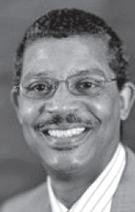
Michigan dealt with a lengthy COVID-19 shutdown but was the class of the Big Ten throughout the season.
The Wolverines closed with a 20-4 record and a No. 1 seed when the tournament began.
“I didn’t sit on my hands when I was an assistant with the Miami Heat. I sat there and I learned,” he told the media after a big win at Indiana earlier this season.
He said playing for coaches Jim Lynam, Bernie Bickerstaff, Jeff Van Gundy, Doc Rivers, Larry Brown, Don Nelson and Erik Spoelstra offered valuable insight.

Photos courtesy of playersbio.com, KARK.com
Michigan’s Juwan Howard led the Michigan Wolverines to the ‘Sweet 16’. Michigan is last of nine Big Ten teams remaining in the tournament.
now belongs to some stellar young
Congratulations to Final Four Teams
Several other schools from the St. Louis metro area also competed in last weekend’s Final Four. Congratulations also go out to:
• Webster Groves’ girls who finished second in the Class 6 state tournament. The Stateswomen pulled off the biggest upset of the weekend with an upset of state powerhouse Springfield Kickapoo in the semifinals.
• Vashon’s girls finished third in the Class 4 state tournament in their first ever Final Four appearance.
• The Westminster Christian boys finished as runners-up in the Class 4 state tournament after playing Vashon a very competitive game in the state championship game.
• Chaminade College Prep finished third in the Class 6 state tournament behind a big effort from 6’10” junior forward Tarris Reed, Jr., who averaged 28 points a game.
• Fort Zumwalt North finished fourth in the Class 6 tournament in the school’s first ever Final Four appearance.
• Lutheran South’s boys finished fourth in the Class 5 state tournament after making an excellent postseason run.
• Union’s girls finished third in the Class 5 state tournament behind the play of stellar senior point guard Reagan Rapert.
“We have a job to do and we’re going to work through whatever challenges that we have,” Hamilton told reporters after his team’s first-round win over UNC-Greensboro.
“My guys depend on me. If
“Those are some Hall of Fame coaches I just named. I picked up a lot of learning from how they coached me,” he said. Houston’s Kelvin Sampson is an “either love him or hate him” basketball coach.
After landing the Oklahoma job, he was named National Coach of the Year in 1995
and the Sooners returned as a national power. There were whispers of impropriety on the recruiting trails, but Sampson rode his success to Indiana.
He was a big-time winner. But he lasted only two years before being forced to resign because of NCAA allegations.
He was an assistant NBA coach before Houston put its
faith in him four seasons ago.
It has been rewarded with a 104-23 record, two AAC regular season titles, a No. 2 seed in the tournament and a Sweet 16 appearance against Syracuse this weekend. Sampson was also awarded a contract extension through 2026-27.
“I am looking forward to continuing our jour-
ney of building our basketball program to the best it can be,” Sampson said. “The greatest joy I have in coaching is being with these young men every day. I look forward to continue developing them on and off the court and chase championships.” The Reid Roundup What the hell happened to
Cuonzo Martin’s Missouri Tigers?...SLU’s early exit from the NIT was also quite disappointing…Had VCU been forced to withdraw from the NCAA Tournament a few days earlier, SLU would have replaced them. Oh well…E.J. Liddell of Ohio State and Kofi Cockburn of Illinois received racial insults and threats after their respective teams were upset in the NCAA Tournament’s early rounds…Fourteen women had sued Deshaun Watson for alleged improprieties while receiving massages as of Tuesday. Is it about the money or the alleged crimes?.. Elgin Baylor, an 11-time All-Star and 10-time All-NBA selection with the L.A. Lakers and a longtime L.A. Clippers GM died at age 86 on Monday, March 22. Alvin A. Reid was honored as the 2017 “Best Sports Columnist – Weeklies” in the Missouri Press Association’s Better Newspaper Contest and is a New York Times contributor. He is a panelist on the Nine Network program, Donnybrook, a weekly contributor to “The Charlie Tuna Show” on KFNS and appears monthly on “The Dave Glover Show” on KMOX.
By Rebecca Rivas Special to The American
Edna Scott and Juan Chambers arrived early at St. Francis Xavier College Church on Tuesday morning. But the line was already out the door.
Just like them, about 20 people were waiting at 9 a.m. to get into the church’s identification outreach program. They needed birth certificates or state IDs in order to get jobs, housing, food stamps. And if Missouri lawmakers get their way, they’ll need a state ID to vote.
“I haven’t tried to seek a birth certificate in a long time,” Chambers said, “and now we’re trying to get an apartment. We both need our birth certificates.”
Scott doesn’t know if her birth certificate was issued in Missouri or Illinois. If it’s in Missouri, she’ll be able to get it in a day — though she has to physically go to St. Louis City Hall to check. If it’s in Illinois, that could take up to six weeks.
“That’s just because Illinois is pretty backed up,” said Tess Sanders, an outreach coordinator at the church, which is located on Saint Louis University’s campus.
The volunteers that are helping Scott and Chambers made calls to city and state agencies to help guide the couple through the process. Throughout the room, about 25 volunteers are doing the same with people sitting at the other 10 tables.
And they’re working through a variety of challenges. Some states require photo IDs to obtain birth certificates.
In Missouri, you must have a birth certificate to obtain a state-issued photo ID.
It’s a catch-22, Sanders said. The church’s ID and birth certificate program, which is the cornerstone of its social ministry, sees about 60 to 80 people every Tuesday. On average, they help 3,400 people a year, helping them obtain about 2,200 Missouri IDs and 1,700 birth certificates.
And they cover the costs to obtain these documents, which totals about $50,000 every year, said Christine Dragonette, director of social ministry at the College Church.
Initiated in 1993, it’s the only program in the state that’s helping people at this volume. And if the Missouri Legislature is successful in re-instating a voter ID law this year, the group’s efforts wouldn’t be anywhere close to enough to reach everyone that might need help.
“There are thousands of people that we work with and thousands more across the state who have experienced barriers to getting IDs,” Dragonette said. “We have no illusions that we meet the entire need for photo identification across the St. Louis region even.”
Voter ID law
Since 1993, St. Francis Xavier College Church has been helping people obtain state IDs and birth certificates, which are needed to get jobs and obtain services. If the Missouri Legislature is successful in re-instating a voter ID law this year, people will need a state-issued ID to vote.

with folks every week — who don’t easily have access to a photo ID — were rightly incensed and really wanted to respond,” she said.
They wrote a response letter, and the Voter Protection Coalition and other groups involved in the lawsuit sought Dragonette out. The lawsuit stemmed from a voter ID constitutional amendment approved by Missouri voters in 2016 that only allowed someone to cast a ballot without a state-approved photo ID after signing an affidavit under the penalty of perjury.
In January 2020, the Missouri Supreme Court struck down the affidavit because it deemed it to be “misleading,” and therefore unconstitutional.
In the same ruling, the court considered the state’s request to strike the non-photo ID options altogether – which is what the pending legislation would do – and concluded that it posed “constitutional concerns and could not have been adopted by this Court.”
While the state is supposed to provide IDs to people for free if they can’t pay, there are still costs involved in getting the documents needed to obtain the ID, the Supreme Court’s ruling noted.
Missouri Republicans have been trying to enact a state-issued photo ID requirement to vote for the last 15 years. Legislation has passed several times, but it’s never been able to fully withstand legal challenges.
In February, the Missouri House passed a bill requiring registered voters to have a government-issued photo ID to vote, or only be allowed to cast a provisional ballot on Election Day.
The Missouri Senate is expected to hold a public hearing on the bill soon.
Provisional ballots can only be counted if the voter returns later that day with a photo ID or if election officials can verify their signature based on voter records.
Last November, only 2,139 provisional ballots were counted out of 5,256 that were cast, according to the Missouri Secretary of State’s Office.
There were 2,407 ballots rejected because the individuals were not registered or eligible to vote, according to
secretary of state records.
There were 920 people who arrived at their right polling place but didn’t have the correct form of ID, so they cast a provisional ballot. Of those votes, 484 were counted. Records do not specify why 375 ballots were rejected, but 40 were cast out because the signatures on the ballots didn’t match the signatures in the voter registration records.
“Requiring a photo ID to vote would absolutely disenfranchise a whole host of people who are already disenfranchised in so many ways,” Dragonette said.
About two years ago, Dragonette joined a lawsuit against the Missouri Secretary of State and Department of Revenue offices for the new voter ID law.
It all started with a letter to the editor in the St. Louis Post-Dispatch that argued everyone can easily obtain a state-issued ID. “All of our volunteers who work
Also, each person only gets one free ID.
“As a result, with the exception of individuals older than 70 whose photo identifications do not expire, prospective voters, in future elections, will be required to pay a fee to obtain photo identification,” the Supreme Court ruling states.
The Department of Revenue offices that the program works with regularly know about the provision in the law that requires them to provide IDs for free. But volunteers have spoken with officials from many DOR locations that don’t understand this, Dragonette said.
And the voters, themselves, do not know about that provision.
“Each week we tell people about the free ID to vote and get blank stares,” Dragonette said, “because virtually no one has heard of it or knows anything about this resource.”




St. Martha’s Hall is
Complete details can be found here https://trailnet.org/2021/03/05/ were-hiring-marketing-andcommunications-coordinator/


Nurses - $70/hr. for Psych, ICU and ER RNs. Immediate & flexible start dates in Centreville, IL. Flexible scheduling available on all shifts. Fully employer-paid medical & dental. Immediate vesting in 401(k) with 6% employer contribution. All nursing backgrounds will be seriously considered. Call Vicki at Worldwide 866 633 3700, x 108.

community referrals, basic
and help maintain a safe environment. Hours are Fridays, 3:00pm-11:30pm and Saturdays, 7:00am-3:30pm. Preference given to applicants interested in working both these days, but will consider applicants interested in one shift only. Bachelor’s degree in a related field is preferred but not required. Knowledge of women’s issues and the dynamics of family violence is preferred. Must be at least 21 years of age, have a car, and valid driver’s license and insurance. Please email or fax resume and cover letter to: Michelle Rhode, c/o Saint Martha’s Hall, P.O. Box 4950, St. Louis, MO 63108 Fax: (314) 533-2035 Email: micheller@saintmarthas.org

FOR PROPOSAL: SSD 113-21: FIRE PROTECTION FOR ADDITIONS AND ALTERATIONS TO SOUTH TECHNICAL HIGH SCHOOL
A $25 refundable deposit (made out to Special School District) will be required. Project Manual and drawings available through County Blue.
A non-mandatory pre-bid meeting will be held at 2:00 PM on April 1, 2021 at South Technical High School, 12721 West Watson Road, St. Louis, MO 63127. Bids are due at 2:00 pm on April 13, 2021 at Special School District Purchasing Department, 12110 Clayton Road, St. Louis, MO 63131.
Declare In-Home Health Care HIRING PERSONAL CARE ATTENDANTS Apply Online: https://www.ideclarehomehealthcare.com Call (314) 201-3200 for Interview


TUESDAY, APRIL 6, 2021
NOTICE IS HEREBY GIVEN that a General Municipal Election will be held at the designated polling place for each precinct in the City of St. Louis, State of Missouri, on Tuesday, April 6, 2021. The polls will be open between the hours of 6:00 A.M. and 7:00 P.M. for the purpose of electing candidates for Mayor, Comptroller, and Alderman/woman in Wards 4, 12 and the fourteen odd-numbered wards. As a result of the passage of Proposition D on November 3, 2020, all candidates for office on April 6, 2021, will run as non-partisan candidates, but voters may only vote for one candidate for each office, other than for candidates for Member of the Board of Education. Voters may vote for three Board of Education candidates. Voters may also vote “Yes” or “No” on seven propositions – Proposition E (to extend the city earnings tax for an additional five years); Proposition Y (an MSD bond issue); and Propositions 1-5 (MSD Charter amendments).
The last day the Board of Election Commissioners can accept an application to vote an absentee ballot by mail in the April 6, 2021, General Municipal Election is 5:00 P.M. on Wednesday, March 24, 2021. Absentee voting in person will conclude at 5:00 P.M. on Monday, April 5, 2021. The office of the Board of Election Commissioners will be open on Saturday, March 27, 2021, from 9:00 A.M. until 1:00 P.M.
THE OFFICIAL BALLOT WILL BE SUBSTANTIALLY IN THE FOLLOWING FORM:
INSTRUCTIONS TO VOTERS: In today’s election, you have your choice of using either an electronic, touch screen voting machine or an optical scan voting machine to cast your ballot.
IF YOU USE THE OPTICAL SCAN VOTING MACHINE to cast your ballot, you must completely darken the oval to the left of the name of the candidate of your choice. To vote on a proposition, if you are in favor of the proposition completely darken the oval next to the word “YES.” If you are opposed to the proposition, completely darken the oval next to the word “NO.” Do not try to punch through the ballot. Use only the marking device provided to you. If you tear, deface or make a mistake and incorrectly mark the ballot, return it to the Election Judges and obtain a new ballot.
IF YOU USE THE ELECTRONIC, TOUCH SCREEN VOTING MACHINE, follow the directions on the screen to cast your ballot. For each candidate for whom you wish to vote, touch the box on the screen to the left of the name of the candidate of your choice. To vote on a proposition, if you are in favor of the proposition touch the box to the left of the word “YES.” If you are opposed to the proposition, touch the box next to the word “NO.” If you need help in using the machine, please ask the Election Judges for assistance.
FOR MAYOR (Vote for One)
CARA SPENCER
TISHAURA O. JONES
Write-In _______________
FOR COMPTROLLER (Vote for One)
DARLENE GREEN
Write-In _______________
FOR ALDERMAN WARD 1 (Vote for One)
YOLANDA BROWN SHARON TYUS
Write-In _______________
FOR ALDERMAN WARD 3 (Vote for One)
HERDOSIA KALAMBAYI BENTUM BRANDON BOSLEY
Write-In _______________
FOR ALDERMAN WARD 4 (Vote for One)
DWINDERLIN (DWIN) EVANS
EDWARD MCFOWLAND
Write-In _______________
FOR ALDERMAN WARD 5 (Vote for One)
JAMES PAGE
TAMMIKA HUBBARD
Write-In _______________
FOR ALDERMAN WARD 7 (Vote for One)
JACK COATAR
SHEDRICK (NATO CALIPH) KELLEY
Write-In _______________
FOR ALDERMAN WARD 9 (Vote for One)
DAN GUENTHER
KEN A. ORTMANN
Write-In _______________
FOR ALDERMAN WARD 11 (Vote for One)
SARAH WOOD MARTIN
Write-In _______________
FOR ALDERMAN WARD 12 (Vote for One)
VICKY GRASS BILL STEPHENS
Write-In _______________
FOR ALDERMAN WARD 13 (Vote for One)
BETH MURPHY ANNE SCHWEITZER
Write-In _______________
FOR ALDERMAN WARD 15 (Vote for One)
MEGAN ELLYIA GREEN
JENNIFER FLORIDA
Write-In _______________
FOR ALDERMAN WARD 17 (Vote for One)
MICHELLE SHEROD TINA (SWEET-T) PIHL
Write-In _______________
FOR ALDERMAN WARD 19 (Vote for One)
MARLENE E. DAVIS
CLEO WILLIS, SR
Write-In _______________.
FOR ALDERMAN WARD 21 (Vote for One)
JOHN COLLINS-MUHAMMAD
LAURA KEYS
Write-In _______________
FOR ALDERMAN WARD 23 (Vote for One)
JOSEPH A. VACCARO, JR.
Write-In _______________
FOR ALDERMAN WARD 25 (Vote for One)
SHANE COHN
Write-In _______________
FOR ALDERMAN WARD 27 (Vote for One)
CHRIS CARTER
PAMELA BOYD
Write-In _______________
FOR MEMBER OF THE BOARD OF EDUCATION (Four-Year Term – Vote for Three)
WILLIAM (BILL) HAAS
DAVID L. JACKSON, JR.
NATALIE VOWELL
J. L. MENDOZA QUINONES
DAFFNEY MOORE
ANTOINETTE (TONI) COUSINS
EMILY HUBBARD
DAVID MERIDETH
ALISHA SONNIER
MATT DAVIS
Write-In _______________
Write-In _______________
Write-In _______________
PROPOSITION E
Shall the earnings tax of 1%, imposed by the City of St. Louis, be continued for a period of five (5) years, commencing January 1 immediately following the date of this election?
YES – FOR THE PROPOSITION NO – AGAINST THE PROPOSITION
BOND ELECTION
THE METROPOLITAN ST. LOUIS SEWER DISTRICT
PROPOSITION Y
To comply with federal and state clean water requirements, shall The Metropolitan St. Louis Sewer District (MSD) issue its sewer revenue bonds in the amount of Five Hundred Million Dollars ($500,000,000) for the purpose of designing, constructing, improving, renovating, repairing, replacing and equipping new and existing MSD sewer and drainage facilities and systems, including sewage treatment and disposal plants, sanitary sewers, and acquisition of easements and real property related thereto, the cost of operation and maintenance of said facilities and systems and the principal of and interest on said revenue bonds to be payable solely from the revenues derived by MSD from the operation of its wastewater sewer system, including all future extensions and improvements thereto?
YES – FOR THE PROPOSITION NO – AGAINST THE PROPOSITION
CHARTER AMENDMENTS ELECTION
THE METROPOLITAN ST. LOUIS SEWER DISTRICT
PROPOSITION 1
Shall the Plan (Charter) of The Metropolitan St. Louis Sewer District be amended to remove obsolete provisions, modernize certain provisions, references and language and change certain provisions to align with current practices of the District, including but not limited to (a) removing obsolete positions and titles, (b) replacing “city workhouse” with “jail or detention facility”, (c) requiring that the District present annually to the City and County only upon request, (d) adding gender, sexual orientation, familial status, ancestry or national origin and disability to the list of protected classes, (e) providing that notice of proposed rate changes can be given by posting on the District’s website and other digital media, (f) replacing “affiliated with” with “a member of” with respect to the current requirement that no two Trustees appointed from the City or County be “affiliated with” the same political party, and (g) clarifying that documents submitted to the Board of Trustees in connection with an annexation also be made available to the public?
YES – FOR THE PROPOSITION NO – AGAINST THE PROPOSITION
PROPOSITION 2
Shall Article 5 of the Plan (Charter) of The Metropolitan St. Louis Sewer District relating to the passage of ordinances be amended to provide that (a) an affirmative vote by two members of the Board of Trustees appointed from the City of St .Louis and two members appointed from St .Louis County shall be necessary to pass any ordinance, resolution, regulation, rule or order, except that with at least five Board members present and unanimous consent of all Board members present, an affirmative vote of any four Board members shall be sufficient for passage, and (b) ordinances shall take effect immediately upon enactment unless a later date is specified therein?
YES – FOR THE PROPOSITION NO – AGAINST THE PROPOSITION
PROPOSITION 3
Shall Article 7 of the Plan (Charter) of The Metropolitan St. Louis Sewer District relating to the Rate Commission be amended to provide that (a) a Rate Commission Representative Organization shall only have one voting Delegate, (b) the Rate Commission Report shall be issued to the Board of Trustees no later than 165 days after receipt of a Rate Change Notice, (c) the Board of Trustees is deemed to have accepted a Rate Commission Report if not rejected by resolution of the Board of Trustees within 100 days from the date the Rate Commission Report is issued, and (d) a clarification be made to the criteria governing rates so that the financial impact on all classes of ratepayers is considered in determining a fair and reasonable burden?
YES – FOR THE PROPOSITION NO – AGAINST THE PROPOSITION
PROPOSITION 4
Shall Articles 5 and 8 of the Plan (Charter) of The Metropolitan St. Louis Sewer District be amended to provide that (a) compensation of a Trustee shall be $25 for each day of attendance at a public meeting of the Board and (b) compensation of a member of the Civil Service Commission shall be $25 for each day of attendance at a meeting of the Commission, not exceeding $625 in any one fiscal year?
YES – FOR THE PROPOSITION NO – AGAINST THE PROPOSITION
PROPOSITION 5
Shall Article 7 of the Plan (Charter) of The Metropolitan St. Louis Sewer District be amended to permit the District to engage the same independent auditing firm for a period in excess of five consecutive years if the District lets a competitive bid for auditing services and the lead audit partner or concurring partner does not perform auditing services for the District in excess of 5 consecutive years?
YES – FOR THE PROPOSITION NO – AGAINST THE PROPOSITION
YOU HAVE NOW COMPLETED VOTING.
IN TESTIMONY WHEREOF: The undersigned, comprising the Board of Election Commissioners for the City of St. Louis, State of Missouri, have caused this notice to be signed and the official seal of the office to be affixed at the office of the Board of Election Commissioners in St. Louis, Missouri, this 10th day of March, 2021.
BOARD OF ELECTION COMMISSIONERS FOR THE CITY OF ST. LOUIS
JERRY M. HUNTER Chairman/Member
GERALDINE M. KRAEMER GENE R. TODD Member Member
(Seal) Attest: JOSEPH A. BARBAGLIA Secretary/Member
St. Louis Community College will receive separate sealed bids for CONTRACT NO. F21 301, Renovations to Create Office Suite and Study Space at St. Louis Community College at Wildwood Campus, until 2:00 p.m. local time Thursday April 8, 2021. Bids will be publicly opened and read aloud at the office of the Manager of Engineering and Design, 5464 Highland Park, St. Louis, MO 631101314. Specifications and bid forms may be obtained from the Manager’s office, at the above address or by calling (314) 644-9770.
An Equal Opportunity and Affirmative Action Employer
PREBID: March 30, 2021 at 10:00am, Wildwood Commons Area
Bids for Repair Firepit Lake Dam, Jay Nixon State Park, Project No. X2006-01, will be received by FMDC, State of MO, UNTIL 1:30 PM, 4/27/2021 via MissouriBUYS. Bidders must be registered to bid. For specific project information, go to: http://oa.mo.gov/ facilities
ST. LOUIS LIVING WAGE ORDINANCE
LIVING WAGE ADJUSTMENT BULLETIN
NOTICE OF ST. LOUIS LIVING WAGE RATES EFFECTIVE APRIL 1, 2021
In accordance with Ordinance No. 65597, the St. Louis Living Wage Ordinance (“Ordinance”) and the Regulations associated therewith, the City Compliance Official for the City of St. Louis has determined that the following living wage rates are now in effect for employees of covered contracts:
1) Where health benefits as defined in the Ordinance are provided to the employee, the living wage rate is $13.73 per hour (130% of the federal poverty level income guide line for a family of three); and
2) Where health benefits as defined in the Ordinance are not provided to the employee, the living wage rate is $18.27 per hour (130% of the federal poverty level income guide line for a family of three, plus fringe benefit rates as defined in the Ordinance).
3) Wages required under Chapter 6.20 of the Revised Code of the City of St. Louis: $4.54 per hour. These rates are based upon federal poverty level income guidelines as defined in the Ordinance and these rates are effective as of APRIL 1, 2021. These rates will be further adjusted periodically when the federal poverty level income guideline is adjusted by the U.S. Department of Health and Human Services or pursuant to Chapter 6.20 of the Revised Code of the City of St. Louis. The Ordinance applies to employers who are covered by the Ordinance as defined in the Ordinance, where the contract or grant is entered into or renewed after the effective date of the Ordinance, which is November 3, 2002. A copy of the Ordinance may be viewed online at http://www.flystl.com/bdd or obtained from:
City Compliance Official
c/o St. Louis Airport Authority St. Louis, Missouri (314) 426-8111
S.M. Wilson & Co. is requesting bids for Missouri University Psych Center Upgrades & Renovations. Bids must be submitted by Monday, March 29th, 2021 at 1:30 PM. Bid Documents will be available at BuildingConnected.com https://app.buildingconnected.com/public/ 5913928fce945d0a00d28943
You can view the project by logging into the BuildingConnected site by setting up a free account on their Website.
Alternate Locations: Cross Rhodes Reprographics https://www.x-rhodes.com/ McGraw-Hill Dodge On-Line Services OnlyMcGraw-Hill Construction/Dodge https://www.construction.com/access-my-account
S. M. Wilson & Co. is an Equal Opportunity Employer.
Bids for New Comfort Station, Missouri State F a i r g r o u n d s , P r o j e c t N o . F2102-01, will be received by FMDC, State of MO, UNTIL 1:30 PM, 4/8/2021 via MissouriBUYS. Bidders must be registered to bid. For specific project information, go to: http://oa.mo.gov/ facilities
St. Louis Development Corporation (SLDC) is seeking proposals from firms that are qualified to provide legal services associated with the acquisition of properties deeded to the Land Reutilization Authority of the City of St. Louis, Missouri (LRA) as a result of tax foreclosure Sheriff’s sales. The complete RFQ can be viewed online at: www.stlouis-mo.gov/sldc or emailed/faxed by contacting Bonnie Wade, SLDC Law Department at WadeBo@stlouis-mo.gov or 314-657-3759.
Normandy Schools Collaborative will be accepting sealed General Contractor Bids for the construction of renovations to their West Hall Building at the Normandy High School. The entire bidders package will be available electronically on Thursday, March 18, 2021 through TR,i Architects, matt.miller@triarchitects.com . A Mandatory Pre-Bid walk through will be held at 2:00pm (CST) March 29, 2021 with Bids being due on Thursday April 8, 2021 at 2:00 PM (CST). To download the entire Advertisement for Bidders please go to the following website: www.normandysc.org or for an emailed copy contact Matt Miller, with TR,i Architects, at matt.miller@triarchitects.com .
The St. Louis Economic Development Partnership requests proposals to furnish laboratory equipment for the Helix Center, a bio-technology business incubator located at 1100 Corporate Square Drive, Creve Coeur, Missouri 63132. A copy of the complete RFP with equipment specifications is available at https://stlpartnership. com/rfp-rfq/. A five percent bid preference may be available to certified MBE firms. To be considered, proposals must be received no later than 3:00 PM CST on Friday, April 16, 2021.
Great Rivers Greenway is requesting Bids for the application of protective coating to exterior bollards in Gateway Arch National Park. Go to www.greatriversgreenway. org/jobs-bids and submit by April 2, 2021.
Poettker Construction Company is seeking bids from minority and disadvantaged businesses for the MUHC – Psychiatric Center Infrastructure Upgrades Serving Level 1 and Renovate 1N for Adult Assessment and Observation Unit at the University of Missouri in Columbia, MO. A Diversity Participation goal of 10% MBE / 10% Combined WBE, DBE, Veteran Owned Business and 3% SDVE has been established for this contract. All interested and certified businesses should contact Zach Lindberg at 618-526-3339 or zlindberg@poettkerconstruction.com to discuss opportunities. All bids must be received by EOB on Monday, March 29th. Bid documents are available for download through the following link: https:// securecc.smartinsight.co/#/PublicBidProject/569922.

618-526-7654
opened and read aloud at the office of the Manager of Engineering and Design, 5464 Highland Park, St. Louis, MO 631101314. Specifications and bid forms may be obtained from the Manager’s office, at the above address or by calling (314) 644-9770.
and Affirmative Action Employer
PREBID: March 31, 2021 at 2:00pm, Meramec Lecture Hall
ST. LOUIS COMMUNITY COLLEGE
St. Louis Community College will receive separate sealed bids for CONTRACT NO. F21 602, Roof Replacement at Communications Building at St. Louis Community College at Meramec Campus, until 2:00 p.m. local time Thursday April 8, 2021. Bids will be publicly opened and read aloud at the office of the Manager of Engineering and Design, 5464 Highland Park, St. Louis, MO 63110-1314. Specifications and bid forms may be obtained from the Manager’s office, at the above address or by calling (314) 644-9770.
An Equal Opportunity and Affirmative Action Employer
PREBID: Monday, March 29, 2021 at 10:00 am at the Communication South Building at Meramec Campus
RFP #: 57821077
REQUEST FOR PROPOSAL
ARCHITECTURAL DESIGN SERVICES FOR PROGRAM OF REQUIREMENTS –STUDENT CENTER
Harris-Stowe State University (HSSU) is requesting proposals for architectural design services for a Program of Requirements – Student Center. Interested parties may obtain a copy of the Request for Proposals/ Qualifications by emailing: morrowb@hssu.edu
ELECTRONIC PROPOSALS MUST BE RECEIVED
NO LATER THAN: 10:00 a.m. on Wednesday, April 7, 2021 and should be emailed to morrowb@hssu.edu. A link to attend the virtual bid opening will be emailed out to all attendees at the pre-bid meeting at a later date.
PRE-BID CONFERENCE: A pre-bid conference and walk-through will be held on Wednesday, March 31, 2021 at 10:00 a.m. in Room 311 in the Dr. Henry Givens, Jr., Administration building, 3026 Laclede Avenue, St. Louis, MO 63103. Masks will be required for entry into the facility and also at the pre-bid conference and walk-through. Social distancing will also be required in all facilities. Zoom link for pre-bid conference to be forwarded to requestors that send an email to: morrowb@hssu.edu by 3:00 p.m. on Tuesday, March 30, 2021. NOTE: Attendance at the pre-bid conference is optional. The University reserves the right to reject any and all proposals and to waive all informalities in proposals.
The following people are in debt to Gateway Storage Mall of Belleville. The contents of their storage unit(s) will be sold at auction to compensate all or part of that debt. Auction at the Royal Heights location will be held online with www.storageauctions.com on April 13, 2021 at 10:00 AM. A cash deposit will be REQUIRED for all winning bids. Bel. E07 – Michael Anthony, Bel G11 – Demario/Sheila(mom) Dugan Auction at the Mascoutah location will be held online with www.storageauctions.com on April 14, 2021 at 10:00 AM. A cash deposit will be REQUIRED for all winning bids. Bel. 620 – Cathy Maldonado, Bel 530 – Charles Sterling For all rules, regulations and bidding process, please contact www.storageauctions.com . All other questions, please call 618-233-8995 or mail 17 Royal Heights Center, Belleville, IL 62220.
Southeast Regions, P r o j e c
N o . IDIQMCA-1004, will be received by FMDC, State of MO, UNTIL 1:30 PM, 4/1/2021 via MissouriBUYS. Bidders must be registered to bid. For specific project information, go to: http://oa.mo.gov/ facilities
Incinerator System Supplier (ISS) Bissell Point and Lemay WWTF Fluidized Bed Incinerators Project Notice of Request for Qualifications (RFQ)
Notice is hereby given that The Metropolitan St. Louis Sewer District (District) will receive electronic Statements of Qualifications for Design-Build Services for Incinerator System Supplier (ISS) Bissell Point and Lemay WWTF Fluidized Bed Incinerators Project under Letting No. 12565-015.8, at its plan room, WWW.STLMSDPLANROOM.COM, until 2:00 PM on Friday, April 16, 2021
All Statements of Qualifications are to be addressed to the Attention of Mr. Jerry Jung, Project Manager and must be submitted and received by the Plan Room. No submittals will be accepted after the 2:00 PM deadline.
The Project is summarized as follows:
The District desires to pre-qualify incinerator system supplier(s) (ISS) for the construction of a fluidized bed incineration (FBI) system as part of a Design-Build team through a Fixed-Price Design-Build contract at two (2) of its treatment facilities: the Bissell Point Wastewater Treatment Facility (WWTF); and, the Lemay WWTF.
The new FBI systems will include the incinerator reactors, heat exchangers, blowers, emissions control equipment, ash handling equipment, ductwork, controls, and associated items.
Preliminary FBI capacities (firm) are as follows:
• Bissell Point 240 dry tons per day (dtpd) with four units nominally sized for 80 dtpd each.
• Lemay 160 dtpd, with three units nominally sized for 80 dtpd each.
New sludge dewatering processes will also be provided at both WWTFs as part of the design-build contract. Centrifuges will be used to dewater a combined blend of primary sludge, WAS, and scum flow prior to incineration. Sludge cake conveyance from the dewatering centrifuges will be by hydraulically driven piston pumps and will include screw conveyors as needed.
All new equipment and related systems associated with the new incineration and dewatering processes will be located in a new Solids Processing Building constructed at both Bissell Point and Lemay facilities.
Both facilities will be procured as one project using a fixed-price design-build project delivery method. A design-build team will be selected based upon a technical scope of work and fixed price submitted by proposing design-build teams in response to a request for proposal issued by MSD.
Statements of Qualifications will be received from all companies meeting the requirements of the RFQ Documents.
RFQ Documents are available for free electronic download. Please go to MSD’s website (www.stlmsd.com) and look for a link to “ELECTRONIC PLANROOM.” RFQ Documents are also available for viewing or purchase at Cross Rhodes Reprographics located at 2731 S. Jefferson Avenue, St. Louis MO 63118. All Incinerator System Suppliers must obtain a set of RFQ Documents in the name of the entity submitting the Statement of Qualifications. The Metropolitan St. Louis Sewer District is an Equal Opportunity Employer.
By Malena Amusa
Special to The American Radio icon Bernie Hayes, the Wolff Jazz Institute at Harris-Stowe State University, and the National Black Radio Hall of Fame invite all education and music lovers to tribute Historically Black Colleges and Universities (HBCUs) in a virtual ceremony streamed from the National Blues Museum on Saturday, March 27, 2021, 3pm - 4:30pm.
The ceremony will also induct four blues legends into the St. Louis Jazz Hall of Fame and celebrate numerous trailblazing African-American cultural and education icons.
“The purpose of this ceremony is to honor musical greats who have attended HBCUs or were not able to attend yet supported the role of higher education in our society,” said Hayes, a legendary journalist, curator for the Wolff Jazz Institute, and interim director of the National Blues Museum. “Inducting them into the St. Louis Jazz Hall of Fame will help make sure that their legacy is not ignored or lost.”
The inductees are St. Louis natives and fellow greats who were influential in the St. Louis and global music scene, including:
• Hugh “Peanuts” Whalum (1920 - 2019), a multi-instrumentalist renowned for his performances on the tenor saxophone.

• Kirk Whalum (1958), nephew of “Peanuts” and 12-time Grammy-nominated jazz saxophonist.
• Clark Virgil, Terry, Jr. (1920 - 2015), a pioneer of the flugelhorn in jazz, American swing and bebop trumpeter, and mentor to Miles Davis, Dianna Reeves, Herbie Hancock, Quicky Jones and many others.
• Kim Massie (1957 - 2020), an American blues and soul-singing legend from St. Louis.
The virtual ceremony will feature a blues tribute by renowned vocalist Marsha Evans and The Coalition band,
streamed from the Harris-Stowe and National Blues Museum Facebook pages.
It will also illuminate a visual, multimedia tribute to HBCUs and several pre-recorded messages from family and friends on behalf of the four legends.
The Tribute to HBCUs and Local Jazz Legends will be livestreamed from the Harris-Stowe Facebook Page (https://www. facebook.com/HarrisStowe/) and the National Blues Museum Facebook Page (https:// www.facebook.com/NationalBluesMuseum/).
Malena Amusa is communication specialist at Harris-Stowe State University.
Each of the panelists unanimously agreed that they have been met with obstacles in the pandemic; while all five collectively come from different professional backgrounds they still said on one accord how it’s been a challenge, but that they’ve managed to adapt.
“Despite the personal losses I suffered from with the death of my cousins, my two spiritual fathers, and the loss of my job, the pandemic forced me to finally bet on myself,” Spearman said. “It forced me to see what would happen if I put my all into my calling the purpose God has placed on my life.”
Like Spearman, Walker shares the same sentiment that loss brought a season of refocus for him. He believes that while it removed a lot from everyone’s lives, it eliminated distractions for him.
“Individuals were forced to get in or out of situations that were going to grow them and make them into becoming a better person.,” Walker said. “I was at home. I was able to focus on my work, focus more
Continued from B1
for a celebrity or even being a celebrity means absolutely nothing when you take your makeup off, take your hair out, shut the door and look in the mirror,” said McField.
Like the saying goes, time heals. McField managed to get to a place where she forgave her parents and saw them as humans as well as parents.
“I want people to know that we are all humans,” McField said. Every broken person is a
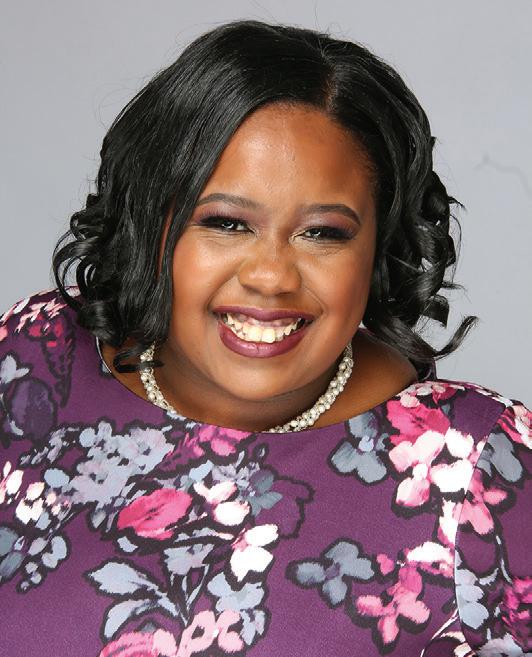
of difficulties. Peterson became slammed with more and more calls as the crises continued rising. She also found that COVID restrictions distanced her from peers she usually would be able to see in person. She took matters in her own hands and birthed two new ideas for both situations.
“I had only so many referrals that could go around, in response I created the “Hey Sis,” journal for women to self-reflect and be encouraged during this time,” Peterson said. “I created ‘Therafriend’ for other therapists around the country and I to connect once a month.”
“People think mental health is not real,” Gardner said. “With COVID, we had to create innovative ways to address needs remotely, by hybrid or in person.”
Each of all the panelists count faith as the driving force behind their resiliency, especially during the pandemic. Phillips strongly believes his faith has pushed him to keep going and pressing forward.
with my clients and focus more on myself internally to become the person I needed to become to be whole.”
For Gardner and Peterson, both found that working in mental health and criminal justice sectors brought its own set
human, every damaged person is a human. We are all humans who have this story and it’s never what it looks like.”
Both parents admit when they married, they were young and didn’t know everything about raising a family, but in hindsight they would do things differently if they could.
“We were young and didn’t know anything about marriage, we had just got married after college only knowing each other for three months,” Robert said. “I wish I could have done better, but I did the best with what I had back then.”
The lesson McField wants people to take away from the
“I’ve had to put my best foot forward in this particular moment and reflect on the progression I’ve made in where I once was,” Phillips said. Learn more about QOR, here: https://www.qornow.com/.
book is that we’re all human and no matter what you’ve gone through it doesn’t define where you will end up.
“Even though you are broken, damaged, marred and flawed you can still do great things,” McField said. “You can still do something great even when you’re all messed up.” McField has since moved back to St. Louis. She has worked as a licensed hairstylist and is currently a Licensed Life Insurance Agent and digital marketing specialist. Learn more about McField, here: https://www.sabrinamcfield.com/.
